

European
Nuclear Society
e-news
Issue 17 July 2007
When asked about what politics meant to him Albert Einstein replied: “Equations are more important to me, because politics is for the present, but an equation is something for eternity.” Well, if Einstein were around today, with all the elections that have taken place in Europe recently, he would have every opportunity to contemplate eternity and to ignore more mundane considerations like radical political reform or forming coalition governments. But would he still play down the importance of politics? Isn’t what happens today the future of nuclear science?
For some of us, science and politics simply don’t mix;
we prefer to stick to science rather than engage in the political process.
For others, trying to influence the political debate in order to secure a better
deal for science and research is essential and many of us actively lobby politicians,
state our case and try to influence the political agenda.
The debate about whether science and the Machiavellian arts are complementary
or immiscible is a familiar philosophical one and we won’t go down that
road now. But consider this: the changing political landscape in Europe could
have profound implications for the future pace and direction of scientific
research, development, education and training. It could greatly influence future
generations of scientists.
A policy rethink on the orientation and funding of research will affect us
all directly. It will redefine priorities, set new deadlines and have a great
impact upon the context and framework within which we work. Of course, we are
not all natural political animals, as Aristotle claimed, but isn’t it
better to take part than observe; to be in motion rather than in inertia? By
playing a more active role in the political process we have a better chance
of making our case heard and refocusing governments’ minds on priority
issues. If we don’t plead our case who will? We should try and influence
things from the inside rather than observe impassively from the outside. Surely
being apolitical is simply not an option – even for those who doubt they
can have much of an effect? Like it or not, being apolitical is simply not
an option.
So, what are these political events that are redrawing Europe’s political map? Firstly, the mandate given by French voters to “citoyen Sarkozy” is a good thing for the nuclear sector. Any lingering doubts about France’s commitment to nuclear energy in the event of a Ségolène Royal victory have been duly dispatched to a deep underground repository somewhere. The EPR programme is now sailing in clear blue water.
Across the English Channel, the UK has taken the radical decision, fired by the pragmatic realisation that its own energy resources are dwindling and that it must act to achieve its CO2 reduction targets, to consider a nuclear new build programme. Britain’s new Prime Minister, Gordon Brown, has lent his support to this, just as his predecessor, Tony Blair, did. Major players like EDF and Westinghouse are jockeying for position in order to cash in on lucrative construction contracts in the UK.
In Belgium, negotiations are underway for the forming of a new coalition government. Yves Leterme, the leader of the Flemish Christina Democrats, is hotly tipped to become the new Prime Minister and he has already come out in favour of reviewing Belgium’s nuclear phase-out policy. But until the composition of the new government is decided, speculation about whether Belgium will follow the advice of the Commission 2030 panel of experts and phase out the phase-out will continue. One thing is certain, though, the science community must makes itself heard and respected sooner rather than later.
Meanwhile, in pro-nuclear Bulgaria, the first Balkan MEPs have taken their place in the European Parliament following a national vote. More pro-nuclear MEPs can have a greater influence on the political debate in the EU and lead to greater visibility for nuclear science and research at both the European and national level.
Speaking of Europe, the re-emergence of nuclear energy as a key element of the EU’s energy strategy has led to the creation of a Sustainable Nuclear Energy Technology Platform (SNETP) and put the Community’s fission research programme under increased scrutiny. Nuclear energy is no longer a taboo subject – marginalised outside mainstream political thinking. The time is right for Europe’s scientific community to do even more to seize the initiative and cash in on nuclear energy’s new-found place at the heart of EU energy policy.
With the EU more favourably disposed towards nuclear energy and more and more governments looking to phase-out their phase-out policy, expand their nuclear base or go nuclear for the first time, the premium for cutting edge nuclear science and research has never been greater. But investing in nuclear means investing more financial resources in the science that is needed to fuel and sustain the nuclear renaissance. Greater investment in human talent – recruiting and supporting current and future generations of scientists – is also vital if the nuclear resurgence is to prove really sustainable. These are areas where we must lead the debate. With a more favourable political wind blowing across Europe right now and the nuclear revival maintaining its momentum, we may never have a better chance to thrust science to the top of politicians’ agenda.
Issue N° 17 kicks off with a word from our President, who urges scientists to communicate more effectively with the general public (and don’t forget that the ENS website is a public one) and rid themselves of the stereotyped view that they are all dressed in white coats and live in an intellectual ivory tower, divorced from every reality. Next up Andrew Teller gives a thought-provoking appraisal of the subtle difference between evidence and absence.
The events section in this summer’s edition of ENS NEWS features a teaser on the upcoming ENC2007, in September, in Brussels.
ENS members continue to send in their contributions in ever growing numbers, which shows the dynamism and motivation of members and helps keep the nuclear science community up to date with everything that is going on in our sector. The contributions this time include a report on the Assisi Symposium on Nuclear Conversion and Development, a personal view of German Presidency of the EU from Peter Leister of the Swiss Nuclear Forum, a feature about the JRC’s new science web portal NUCLEONICA, a report from Sweden about unusual nuclear reactor concepts, a summary of what happened at the recent ICAPP conference and a piece about how new Genitron radio systems are helping to upgrade the safety monitoring process around Chernobyl’s 30 km exclusion zone.
The Young Generation section contains a glimpse into what the future holds for young nuclear professionals - as discussed at this year’s European Young Generation Forum (EYGF), in Amsterdam; a detailed account of the Czech Young Generation’s visit to SKODA’s manufacturing facilities, in Pilsen (Czech Republic) and an early announcement about ENC2008, in Interlaken (Switzerland.
Finally, the World News section contains the latest edition of the NEI’s Nuclear Energy Overview newsletter and two reports from NucNet.
Enjoy ENS NEWS N° 17 and above all have a lovely summer break!
|
|
|
http://www.euronuclear.org/e-news/e-news-17/presidents-contribution.htm


At conferences devoted to discussing nuclear energy most of the papers presented deal with technological or scientific themes. This is certainly not abnormal as most people working in the nuclear field and attending these conferences are scientists or engineers and, therefore, tend to consider that most of the problems relating to nuclear energy - and I mean nuclear energy in the broader sense, including non-power applications - are of a scientific or technological nature and can only be solved as such.
In my opinion, this is the wrong approach. Ever since scientists and academia have existed, they have been accused of living in an ivory tower, not aware of the real concerns of people. One proposition was (and perhaps still is?) that they considered their knowledge to be of such a complexity that it is too complicated to be explained to the general public, and that anyway they were neither interested in explaining it - nor paid to do so. Instead, being the only ones “in the know,” they achieved a high social status.
I think that in this respect much has changed. Today universities and research institutes know that their stakeholders represent society in general and that communicating about the work they do is part of their social duty. Similarly, the industrial world knows that a minimum of objective communication and openness is necessary to gain long-term public acceptance.
Another persisting aspect of the ivory tower image is that we, scientists and engineers, are all too often insufficiently aware of what society really expects - or would like - to hear from us. Let me give you an example: we know that the public is afraid of nuclear accidents occurring. We answer that the probability of a nuclear accident is exceedingly small, maybe 10-5 and, in any case, much smaller than the risk of having a car accident or of suffering from cancer if you smoke. Even though this argument is an objective fact, it does not seem to change public opinion. And yet we still read in brochures about the EPR or Generation IV reactors that there will be much more passive safety in the future and that accident probability will be reduced to 10-6 or 10-7...
The public couldn’t care less about such statements or the statistics quoted because their concerns and fears are not rational but emotional. We tend to answer questions that are of a social, psychological or ethical nature with technological or scientific arguments. Take the problem of radioactive waste: is this a technological or societal problem? Is fear of nuclear terrorism a technological problem or a societal one? I am convinced that purely technological answers to these questions are inadequate.
What’s more, the press tends to vastly amplify the public’s concerns. For the press, only interruptions to life’s smooth and steady course are newsworthy and, therefore, can generate profit. Good news is usually no news, except when it allows us to dream of an idealised world in which some of our fears or imperfections no longer exist. Fear of global warming is a good basis for news: announce a project to build a windmill park and you get the usual headlines. Fear of putting on weight? Then buy a women's magazine etc...
Bad news is always news when it triggers primal concerns. A leaking pump in the cooling circuit of a power plant automatically becomes a “near disaster” for mankind. For the press, non-zero risk means permanent risk.
Politicians all too often deliberately amplify this tendency inn an attempt to try and win the votes of those whose views represent the fringes of the mainstream electorate. What they think personally is of secondary importance compared with the importance of their perceived public image. And what the population really thinks is of less concern to them than what they can make the public think. This, in my opinion, leads to a dangerous and simplistic polarisation of opinion: left = against and right = in favour of nuclear energy.
Some of you may, of course, disagree with what I just said, and reality certainly shows that there are many layers of opinion. But I think that we would all agree that the past has shown how poor communication and lack of understanding of the real public’s genuine concerns can have a devastating effect on the public opinion. This holds true not only for the nuclear field, but also for science and applied science in general. Why, e.g., has the number of students studying nuclear science decreased dramatically world-wide while the number of students studying the 'soft science” continues to increase? Obviously, purely scientific or technological answers are not satisfactory when addressing the question of what kind of society we want to live in or bequeath to our children.
It is surprising, therefore, that most of the research in our sector - and other similarly small sectors - continues to be oriented towards providing technological answers, rather than including research into the more 'human' and 'societal' aspects. It is surprising and, I believe, dangerous.
Indeed, what is our credibility today, as scientists and engineers? Why are lobbying groups such as Greenpeace often considered more credible than we are? What happens to democracy when people who try to do their work honestly and as objectively as is humanly possible - people who are true scientific experts in their field - are not considered credible by the press and politicians alike simply because they do not conform to preset or demagogical opinions?
We should not just blame 'them' however. We created many of the problems we are experiencing today due to our historical lack of transparency and poor communication. But let's learn from the past and think about solutions that will help improve our credibility.
In my opinion, we first need to have the courage to acknowledge that we understand the public has problems and concerns about nuclear energy. It is correct that the amount of power generated in a nuclear reactor can inspire fear as it exceeds by far anything that we can grasp on a human scale: we appear to be tampering with the basic limitations of natural phenomena. It is correct that waste, which remains dangerous for many generations, may also appear frightening when we think about our grandchildren. It is correct that the consequences of a major accident anywhere in the world would affect us all. Acknowledging the validity of people's concerns certainly is a first step towards improving our credibility.
Why not be as open as possible, giving information that is adapted to suit the different levels of knowledge of those who receive it? We are neither the sole source nor the sole guardians of knowledge. And we are not the only ones that can understand how a reactor works. Not giving all the information is perceived as hiding information, which is in turn perceived as tantamount to hiding danger. This is fertile ground for our opponents to exploit on ideological rather than factual grounds.
Finally, we have to distinguish between scientific and technological facts on the one hand and personal or societal values on the other hand. For example: "there is no solution for radioactive waste and the waste is very dangerous". We tend to answer this generalisation by showing that "there are technological solutions or they are within reach and, therefore, the little waste that exists can be disposed in such a condition that it will not be dangerous". We mix scientific facts and technological solutions (depth of disposal site, isotope migration through different shielding barriers, time scales involved etc...) and value-based considerations or globally accepted views (dangerous, acceptable, sustainable etc.). It is not up to us to decide what is dangerous, nor what is acceptable for other people's grandchildren.
In my opinion, it is perfectly reasonable to be against nuclear energy because the risk of a major accident is not deemed acceptable, but it is not acceptable to write that nuclear energy is more expensive than wind energy, because that simply is not true.
Lobbying groups against this or that take every advantage they can to promote misconceptions, incomplete data or lack of openness. They mix facts and values as eagerly as possible. Let us, therefore, study all aspects, not only the basic or applied 'hard' scientific ones, but also the 'human' and 'societal' scientific aspects. Let us communicate facts, without mixing value-based judgments. This does not mean that we should not express our opinions, but instead let's clearly distinguish between facts and opinions. Discussions about facts can and have to be solved by scientific research. The democratic process can solve discussions about opinions. Let us, therefore, be open about our strengths, but also about our weaknesses. And above all, let us acknowledge the respectability of people's concerns. This way we may regain credibility and provide the basic ingredients that will support a democratic debate and encourage sensible decision-making when it comes to nuclear energy.
You may wonder why I have not said anything yet about the ENS. Well, what I propose is exactly what ENS already does! Have a look at our web site, which is indexed in the ISI web of knowledge for the value and credibility of the information that it provides, and is permanently updated. Attend our dedicated conferences, such as PIME (which focuses on communication), TopFuel, TopSafe, TopSeal, RRFM etc. Read our ENS NEWS electronic magazine. And, most importantly of all, have a look at the programme of ENC2007, our biannual congress, which will take place this year in Brussels, from 16 – 20 September. You will see that it provides sessions that focus on both 'hard' and 'soft' science issues.
I hope to see as many of you as possible in Brussels at ENC2007!
Frank Deconinck
President of the ENS
http://www.euronuclear.org/e-news/e-news-17/listening.htm


The promoters of new technologies are usually given a hard time when they try to support their case by pointing out that no detrimental effect of their use has been observed. The sceptics’ favourite rejoinder in such cases is that “absence of evidence is not evidence of absence”. To give but one example, Greenpeace’s Wingspread Statement on the Precautionary Principle1 follows closely this line of reasoning. One of the participants who contributed to drafting the Statement was quoted to say (disapprovingly): “Many policy makers and many in the public believe that if you can't prove it is true, then it is not true.” This is tantamount to asserting that, even if you can’t prove it is true, you should nevertheless act as though it was true. This approach has been heavily adopted in particular to counter the observation that no or hardly any damage can be ascribed to low-level radioactivity. More generally, the absence-evidence argument can be used in circumstances ranging from enquiries in the philosophy of knowledge, where its truth is of theoretical importance, to the interpretation of statistical surveys, where its truth is of little value. The fact that it can come in support of otherwise untenable opinions, such as the existence of fairies and unicorns should also ring an alarm bell. The reader might be interested in hearing that it is possible to demonstrate that failing to find evidence supporting statement X does lower the estimate of the probability that X is true, regardless of any other consideration2.
What I would like to do here is to focus on the use made of the absence-evidence argument against statistical analyses. When confronted with its concise and elegant wording, many will find it difficult not to behave defensively. The standard response to it would go as follows: “of course, I do not mean that absence of evidence entails evidence of absence; I know that the latter cannot be logically inferred from the former, but demanding a proof of absence is not reasonable either. It means proving the truth of a statement, which is an impossible task. E.g., assume you set out to prove that all swans are white. No matter how many white swans you record, doing so does not preclude the possibility of coming across a black one sooner or later, which means that such efforts are doomed to failure”. The point made is that statements can only be proven false. The theory that the progress of knowledge follows not from a steady accumulation of truths, but only from the gradual elimination of errors, is due to the famous philosopher Sir Karl Popper3.
To Jean-Pierre Dupuy4, a sceptic of nuclear energy, this Popper-inspired argument is but a smokescreen. He states that the controversy surrounding the harmfulness of, say, product X can be cleared by conducting a sampling experiment aimed at testing the danger of X. If no positive conclusion is obtained, the parties would just have to make sure that this outcome is not due to chance with a suitable level of (statistical) confidence. Jean-Pierre Dupuy quotes the customary value of 95%, indicating that he is willing to settle the matter if there is no more than a 5% (one in twenty) probability that the outcome obtained is a random effect. If only things were this simple. First, I am not sure that the “anti-nuclears” would accept a 95% level of confidence. Second, a less cursory analysis (details are given in the appendix) shows that it is not just a question of agreeing the confidence level but also the number of tests N conducted, the probability of harm being related to both of them. There are, therefore, two degrees of freedom, not just one. So, there is also ample room for haggling about the size of the sample. And this is what happens when critics claim the harmfulness of product X will finally start being revealed with the tests coming after the Nth one. But this is nonsense because if many tests have been performed with a negative outcome, observing after these a sudden reversal of outcomes is a very unlikely event. As in many cases, ignorance (in this case of probability theory) makes it easier for the critics to stick to their guns. At the end of the day, whichever way one looks at it, absence of evidence does not leave much room for presence. So let us not allow ourselves to be fooled by the evidence-absence argument: its effectiveness stems from the fact that it moves the discussion to an area that is foreign to the point at issue. In a statistical context, absence of evidence is, of course, not evidence of absence, but it surely is a strong indication of absence. A subtle difference indeed, but one worth bearing in mind.
Appendix
If p is the probability of the event investigated, the likelihood L of it not
appearing after N tests is given by

In order for this outcome not to be ascribed to chance, L(p) must be greater than a value a such that the range 1 – a is sufficiently large:
![]()
If we want the range covered to be equal to 95%, we must therefore take a = 5%. Taking the natural logarithm of both sides and remembering that ln (1 – p) ˜ -p for p<<1, one obtains
![]()
The sampling experiment so defines for p an interval of values ranging from 0 to
![]()
E.g., for N = 1000 and ![]() =
5%, pmax = 0.003. As noted in the main text, a and N are independent
from one another. In particular, modifying N does not affect the confidence
interval. Other conclusions entailed by the foregoing are:
=
5%, pmax = 0.003. As noted in the main text, a and N are independent
from one another. In particular, modifying N does not affect the confidence
interval. Other conclusions entailed by the foregoing are:
Insisting on a 99% confidence level (![]() =
1%) would not change the situation noticeably since - ln
=
1%) would not change the situation noticeably since - ln ![]() =
4.6 instead of 3 for
=
4.6 instead of 3 for ![]() =
5%, giving pmax = 0.0046 instead of 0.003.
=
5%, giving pmax = 0.0046 instead of 0.003.
In the case of one single instance of harm occurring any time over N tests, the expression of L(p) is given by the binomial law:
Expressing that L(p)must be ![]() gives
an inequality in the unknown p that can be solved for given values
of N and
gives
an inequality in the unknown p that can be solved for given values
of N and ![]() with
the help of a spreadsheet solver. Still for N = 1000 and
with
the help of a spreadsheet solver. Still for N = 1000 and ![]() =
5%, pmax
=
5%, pmax ![]() 0.0045.
This value is slightly bigger than the value obtained above but the
best estimate value of the statistical analysis is now equal to 0.001,
lower than the previous upper value = 0.003!
0.0045.
This value is slightly bigger than the value obtained above but the
best estimate value of the statistical analysis is now equal to 0.001,
lower than the previous upper value = 0.003!
If one assumes that, after 997 negative outcomes, one might get three positive ones in a row, p being equal to 0.003, one would be postulating that one must expect the occurrence of an event the probability of which is equal to 0.0033 = 2.7 10-8, a most unlikely event. If N negative results have been obtained, N being large enough, insisting on pursuing the tests is ignorance in the best case and bad faith in the worst case.
1 The text of the full statement can be easily found on Greenpeace’s website with the help of a search engine.
2 sigfpe.blogspot.com/2005/08/absence-of-evidence-is-evidence-of.html or oyhus.no/AbsenceOfEvidence.html
3 The Logic of Scientific Discovery (latest edition available to be looked for)
4 Jean-Pierre Dupuy, Pour un catastrophisme éclairé (For an enlightened gloom-mongering), Editions du Seuil, Paris 2002, page 89.
http://www.euronuclear.org/e-news/e-news-17/enc2007.htm

 |
|
 |
|
|
|
|
| ENC 2007 Diamond Sponsor |
||
| ENC 2007 Diamond Sponsor |
||
ENC 2007 is organised |
||
in cooperation with the OECD/NEA |
http://www.euronuclear.org/e-news/e-news-17/Assisi-Symposium.htm

The Megatons to Development project
aims to promote the conversion of nuclear warheads into nuclear fuel and
to use part of the income raised to finance development projects in the
southern hemisphere.
The Assisi Symposium on 13 and 14 April (Figure 1) took place at the Holy
Convent of the Franciscan Order. It focused on the possible leading role
that the European Union could play in promoting this project, which was
proposed by the Italian NGO Comitato per una Civiltà
dell’Amore (Committee for a Civilisation of Love).
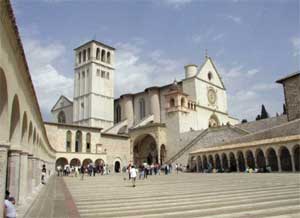
Figure 1: Updating Nuclear Peace and Development Symposium
at the San Francesco Sacred Convent in Assisi, with the participation of
well-known experts in the institutional, scientific, political and technological
aspects of international diplomacy (April 13 and 14, 2007 and October 15,
2005).
The symposium consisted of a series of presentations, followed by discussions during round table sessions. During the part of the meeting devoted more specifically to nuclear issues, which was chaired by Enrico Mainardi of AIN (the Italian Nuclear Association), a presentation was given by Bertrand Vieillard Baron entitled Global Worldwide Perspectives for Nuclear Power. The international focus of this presentation was the starting point for an interesting discussion on nuclear issues related to the main theme of the meeting.
The Comitato per una Civiltà dell’Amore held organised other official meetings in Assisi and Rome to discuss the proposal. The programme Conversion of Nuclear Weapons into Development Projects in the Southern Part of the World was first presented at the Italian Convention in Rome, on 11 November 2004, and subsequently at the International Convention of Assisi, on October 15, 2005. The socio-economic and technical aspects of the programme had been discussed at length with NGOs, scientists and ambassadors, together with the support of the Holy See. Irrespective of one’s personal religion convictions it was agreed that the use of nuclear weapons to indiscriminately destroy entire cities or areas, often wiping out their populations, should be unreservedly condemned. Using nuclear weapon materials in nuclear reactors to generate electricity is without doubt an initiative that promotes peace.
Thanks to international agreements reached on nuclear disarmament, the conversion of uranium from nuclear warheads into fuel for nuclear power plants is already in progress. The USA and Russia kicked off the Megatons to Megawatts Programme in 1992 thanks in part to the research first carried out in Italy by the late Edoardo Amaldi. Amaldi was an Italian scientist who, together with Enrico Fermi, contributed greatly to research and development in the field of nuclear energy.
In June 1992 the International symposium Conversion of Nuclear Warheads for Peaceful Purposes took place in Rome (Figure 2). Studies and analyses carried out by Italian, American, Russian, German, Japanese, French and Belgians scientists were presented in the presence of the Holy Father, Pope John Paul II. During the meeting an important speech was given by V. Mikhailov (the then Minister of Energy of the Russian Federation). Subsequent contacts were developed with a view to establishing Russian-American cooperation agreements.
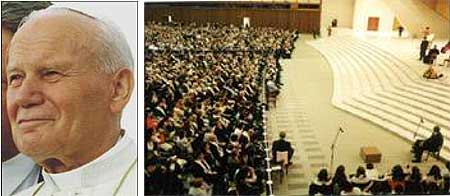
Figure 2: International Symposium on the Conversion of Nuclear
Warheads for Peaceful Purposes, Rome, June 15 -17, 1992, in the presence
of the Holy Father, Pope John Paul II.
In the same year, the First International Symposium of Scientists and executives from the USA, Russia, Japan and Europe took place (Figure 3).
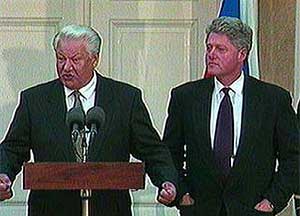
Figure 3: Presidents Yeltsin and Clinton at the time of the
First International Symposium of Scientists and Executives from USA, Russia,
Japan and Europe on the conversion of nuclear arms into fuel for nuclear
power plants, just before the USA-Russia nuclear conversion programme Megatons
to Megawatts was launched, in 1993.
In 1993, the USA-Russia nuclear conversion programme Megatons to Megawatts started up with the main goal of converting 20,000 nuclear warheads into fuel for nuclear power plants. Up until now, conversion activities have eliminated the equivalent of 12,000 nuclear warheads by converting them into nuclear fuel for use at commercial nuclear power plants. According to the US enrichment company USEC, 300 metric tonnes of highly-enriched uranium (HEU) from Russian nuclear warheads have been downgraded to low-enriched uranium (LEU) fuel as part of the so-called Vital Energy and Non-proliferation Programme.
US commercial nuclear reactors use this LEU fuel to generate about 10% of the country’s electricity. The Megatons to Megawatts programme is now 60% complete. When the programme is completed in 2013, 500 tonnes of HEU – the equivalent of 20,000 nuclear warheads – will have been downgraded to LEU fuel. USEC implements this 20-year commercial agreement on behalf of the US government, in partnership with the Russian nuclear fuel cycle company Techsnabexport (Tenex). USEC pays Tenex for the separated work elements contained in the fuel. Up until the end of 2006, USEC had paid Russia more than 4.6 billion US $ (3.4 billion €). With annual purchases of more than 500 million US $, USEC expects to pay Russia more than 7.6 billion US $ by the end of the contract, in 2013. The LEU fuel obtained so far from the downgraded HEU can be used to generate enough electricity to power an average-sized city for more than 460 years, according to USEC. (www.usec.com/, www.tenex.ru/english.html)
The Megatons to Megawatts initiative is the main point of reference for this new Megatons to Development programme. A technico-economic feasibility study on the conversion of nuclear weapons into development projects in the southern hemisphere has been proposed. The conversion of weapons of mass destruction into new economic resources, starting from nuclear warheads currently being dismantled, would reduce the risk of apocalyptic disasters and create a new atmosphere for peace.
The energy obtainable from the uranium from 60,000 warheads (more than 1,000 tons of HEU) is equal to the power consumption of the world’s total population in one year. According to the organizers of the Assisi meeting, if all nuclear warheads were converted into fuel for nuclear power plants it is possible to benefit from an economic “dividend”. A preliminary assessment of this dividend has been made and with the appropriate support and consensus it can be used to boost development in the southern hemisphere. It is necessary to lobby the governments of the countries directly involved in the conversion of uranium, so that the return can promote economic development. It is also important to promote intergovernmental cooperation. The programme is very ambitious and must be very well organized. In this way Europe can contribute to the conversion of nuclear warheads via disarmament and can help the development of poor countries.
During the meeting in Assisi a kind of support programme – mainly in the southern hemisphere – has been proposed. This support is based on development activities in the form of mini-projects. According to the Comitato per una Civiltà dell’Amore, these mini-projects can be more effective than major ones. This has been borne out by mini-projects successfully carried out by missionaries, NGOs and, recently, by some international organizations.
The objectives of the programme remain of significant relevance today – especially considering global changes that have taken place over the last 15 years. The development needs of poor countries must, more than ever before, be taken into consideration, without ignoring that now Russia and China (and very soon India) are major players on the global energy stage. One must not forget the political changes that have taken place in the Middle East during the same 15 years, as they too are relevant in today’s world political scenario.
Justice, peace and dialogue were the main messages to emerge from the Assisi Symposium. When it comes to nuclear issues, justice, peace and dialogue for the entire world is a must - irrespective of culture or religion. Even if some of these proposals seem very ambitious, discussions are nevertheless necessary due to the present world situation. At the moment greater political and institutional support is needed in order for the Megatons to Development programme to take off. The European nuclear industry, NGOs and European Institutions can help promote this process of conversion and development. And the role of international organizations must be amplified too.
|
||||
http://www.euronuclear.org/e-news/e-news-17/nuclear-news.htm

|
When Germany took over the six monthly presidency of the EU-Council at the beginning of 2007, the start of this period fell right in the middle of in the so-called “fifth season.” This phenomenon is unique to Germany and manifests itself by a part of the population going crazy for a couple of weeks. It is more commonly known as the carnival season. One of the first important tasks facing the German Chancellor Angela Merkel and her |
team was to organise the European Energy Summit, during which EU Member States were supposed to establish reference points for the EU’s future environment policy in response to the global climate change challenge. The circumstances surrounding it sometimes assumed carnevalesque proportions.
First, Germany announced that it sees itself as the pace-setter in environmental matters and wants to establish itself as an exemplary paragon of virtue as far as environmental technologies and politics are concerned – a paragon whose lead other nations (not only European) should follow.
When asked by the European Commission’s Environment Commissioner, Stavros Dimas, whether the attempts of German car manufacturers to reduce their vehicles’ CO2 emissions had proven successful and could be frozen from 2008 onwards at 140 g CO2/km (as they had voluntarily declared to do nine years ago) Ms. Merkel was put on the spot. The German automobile industry warned of drastic losses of employment should this choice become reality to respond and urged Mrs. Merkel to respond accordingly. She was forced to admit to Brussels that German automobile engine development will take a couple more years to achieve this goal than it originally foresaw. Other European car manufacturers, however, are not far from achieving thet target. After a tough round of negotiations Commissioner Dimas set a new European target at 120 g CO2/km, which is applicable from 2012 onwards.
Soon, a showdown of theatrical proportions started between the German Environment Minister, Mr. Gabriel and his fellow minister responsible for traffic and transportation, Mr. Tiefensee. Mr. Gabriel claimed that he would reduce the maximum speed on German motorways to 120 km/h in order to enhance car drivers’ safety (Hear, hear!). Mr. Tiefensee then counter-claimed that he would introduce a law obliging car producers to declare the CO2 emissions of any new car as an indication of the car’s quality and energy performance. This would enable customers to choose cars based on their environmental characteristics (Hear, hear!).
Mr. Gabriel then turned his attention to the subject of Germany's phasing-out of nuclear power. He stressed that Germany can only influence global warming by modernising its coal fired plants – as well as by boosting its renewable energy output and by encouraging drastic energy savings. His argument can be summarised for the benefit of the layman as follows: CO2 and radioactivity are both “toxic”, but Germany cannot phase out both nuclear and coal-fired plants simultaneously! So, the latter stays and the former goes! He then took the opportunity to participate in a ceremony of laying the foundation stone for a new, modern lignite plant.
Mr. Beck, President of German Social Democrats, then topped this argument, explaining to the astonished German nation that nuclear power plants would emit more CO2 than lignite plants! It was that well-known anti-nuclear scientific institution, the Oeko-Institute Darmstadt that was embarrassingly forced to clarify the confusion he had caused.
Meanwhile, the beleaguered Mrs. Merkel somehow managed to make a success of the European Energy Summit. Clever as she is, the day before the conference she met with France's President Chirac. The result was that at the summit, states generating nuclear power received the political “permission” to continue producing CO2- free electricity - except, yes you’ve guessed it - Germany!
Incidentally, Mrs. Merkel is a physicist who received her “politically education” from former Chancellor Helmut Kohl, for whom she served as Environment Protection and Energy Minister. She is continuously showing her skill and ability to lead the Germany’s “grand coalition” in what she, as the person in charge of driving through Germany’s presidency of the EU, feels is the right direction.
The Energy Summit came out with an easy play on the figure of five times 20: the first two of which stand for the year 2020, the next figure 20 means 20 % CO2-reduction, the fourth means 20 % reduction of energy consumption and the 5th means 20 % enhancement of renewable energy. This is the new earth-shattering world formula…. Sorry Mr. Einstein.
Shortly after the Summit, the second UNFCCC report on global climate change was published, shocking the world. Expressis verbis, the use of nuclear power as an important contributor to CO2 reduction was mentioned amongst others, but Mr. Gabriel’s messianic message to the world was now “BIOMASS.”
Biomass, an apparently promising alternative energy source, is now the shining star in Germany and held up, in his view at least, as THE solution for the world’s global climate problems. Rape seen and maize should become the main ingredients for new greener car fuels and electricity production. Maize and rape seed sound like a simple recipe – an open sesame. To meet Germany’s fuel demand, German agricultural land will be used in the future to produce diesel, gasoline – not to mention food too. Now we have to learn how clever and global the strategy for promoting green renewable energy technology has become. Very impressive! Biomass-based district heating plants used as cogeneration plants are under construction. And they will be fed by.... wait for it… palm oil!
Palm oil? Why? Well, according to German environmentalists, the total CO2 balance of rape seed is negative. Instead of rape seed, palm oil has to be imported from tropical countries. Thank goodness this was found out so early! Well, as far as producing palm oil in special tropical farms is produced, tropical rain forests first have to be destroyed to make room for palm tree farming to be developed. By burning down the tropical forests a huge part of the CO2 that they are supposed to be reducing is actually produced instead. Perhaps they should have stuck to rape seed-driven power plants after. What a stroke of a genius.
But wait a minute! What more do we know about maize and rape seed? Well, for example, if Germany were to replace all its present diesel consumption by rape seed produced energy, the land area that Germany currently has set aside for agricultural production wouldn’t even be large enough to cover the needs of the environmentalists’ strategy.
I say it again…what a stroke of genius!
German farmers will become monopolists and play around with citizens’ lives: It’s a simple choice, what do you want, diesel or food?
A lot of problems could be solved with a step-by-step approach.
Step 1: the unemployed will be sent to work in the countryside. Throughout the year they can be kept busy with light work that is easy to understand, doesn’t require expert knowledge or training; harvesting rape seed and maize does not require much intellectual insight or ability – which, incidentally, the Polish asparagus harvesters who annually flooding over Germany's fields in the early summer certainly do have. Farmers will be the main employers, no trade unions are necessary and the car manufacturers can sell their old-fashioned harvesting machines once again - such classic models as Daimler’s Unimog ® or Porsche’s Diesel-Bulldog ®. BMW, however, has no agricultural heritage….
Step 2: The health and care system could
be revolutionised and drastically simplified. Air in the country is clean
per definition. Working in the fields is, per se, healthy. The numbers of
hospitals can be reduced. Cities will be emptied. Since people will live
in the country, doctors will not be so important. What would we need pharmacists
for, once ill health is reduced to a few standard illnesses?
OK then. Why not also reduce the numbers of schools and universities. Children
will first be sent to kindergartens, then to plant nurseries and, finally,
out to work in the fields. What a healthy, idyllic and productive life;
Step 3: Germany changes. It will revert back to being an agricultural state. Why not? The obvious advantages of such a scenario are clear for all to see: the numbers of cars per family can be reduced. Motorways and highways will no longer be clogged up with traffic. What would anyone need an off-road vehicle for? People would be working all the year off-road! Even politics would become easier because only two political parties would be required; one representing Diesel harvesting interests and the representing the giant food production sector. What an ingenious simplification of the democratic process! What a logical and effective strategy for reducing CO2 emissions to a new German world record level (something that already claimed by Mrs. Merkel).
Yes indeed, an unprecedented stroke of a genius!
All other nations will admire Germany and learn from it. Fortunately, we in Switzerland are looking again, sensibly and thoughtfully, at the "bigger canton".
http://www.euronuclear.org/e-news/e-news-17/nucleonica.htm

J. Magill1, J. Galy1, R. Dreher1, D. Hamilton1, M. Tufan1, C. Normand1, A. Schwenk-Ferrero2, H. W. Wiese2
1 European Commission, DG Joint Research Centre,
Institute for Transuranium Elements, Postfach 2340, 76125 Karlsruhe, Germany
2 Forschungszentrum Karlsruhe Technik und Umwelt, Postfach 3640,
76021 Karlsruhe, Germany
Abstract. NUCLEONICA is a new nuclear science web portal from the European Commission’s Joint Research Centre. The portal provides a customisable, integrated environment and collaboration platform for the nuclear sciences using the latest internet “Web 2.0” dynamic technology. NUCLEONICA is aimed at professionals, academics and students working with radionuclides in fields as diverse as the life sciences (e.g., biology, medicine, agriculture), the earth sciences (geology, meteorology, environmental science) and the more traditional disciplines such as nuclear power, health physics and radiation protection, nuclear and radio-chemistry, and astrophysics. It is also used as a knowledge management tool to preserve nuclear knowledge built up over many decades by creating modern web-based versions of so-called legacy computer codes.
Due to a general lack of interest in nuclear power over many years, particularly in Europe, there has been a gradual decline in the nuclear skills base. The nuclear field has become very much a “grey-haired profession” with an ageing population of nuclear professionals. Today, as a result of recent developments on issues such as energy security and protection of the environmental, we are witnessing a resurgence of interest in nuclear power. In order to support this development we will need a nuclear skills renaissance in education, training, and knowledge management in the nuclear field.
There is also large range of “non-power” applications of radioisotopes and radiation in a variety of diverse fields such as medicine (e.g. cancer therapy), agriculture (e.g. pest population control), food irradiation (e.g. to increase shelf-life) and in industry (e.g. tracers, radiography, gauging, radiation processing, etc.), where such nuclear skills are also required.
To support this renaissance, we have developed a nuclear skills "toolbox" using the latest internet technology. This toolbox can be used for daily activities by experts, teachers, postgraduates and students of nuclear science. The nuclear skills toolbox proposed above takes the form of a Nuclear Science Web Applications Portal: NUCLEONICA [1] to encompass the knowledge of generations of nuclear scientists (in the form of databases, software applications, etc.) and make this available in a modern, user-friendly way which is fast, accurate and cost effective using the latest internet technology. In particular NUCLEONICA consists of an integrated environment and collaboration platform through the internet (databases, software applications, training courses) providing a one-stop, user friendly, fast and accurate nuclear science information source to allowe experts and non-experts alike to concentrate on scientific results rather than tedious background chores.
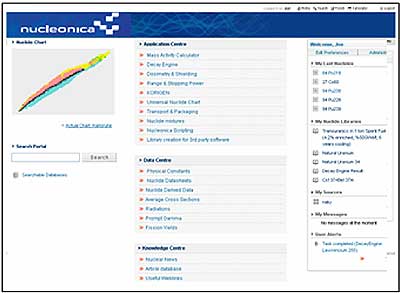
Fig.1. The NUCLEONICA web portal showing access to the Application,
Data, and Knowledge Centres. NUCLEONICA will keep track of user activities
by customising (remembering and storing) these in a Personalized Desktop.
NUCLEONICA makes use of cutting-edge internet technologies such as AJAX (Asynchronous JavaScript and XML) and offers security enhanced “software as a service” (SaaS) on the web rather than software on a PC thus avoiding problems of software licensing, installation, updates etc. The web applications are browser and operating system independent and can be accessed with Internet Explorer, Mozilla-based browsers (Mozilla, Firefox, Netscape) and a variety of other browsers such as Opera, Safari, etc. Another Web 2.0 feature is the Personalised Desktop with detailed user rights configurable via administration menu. A Mobile Device Portal is also available for a variety of mobile devices.
NUCLEONICA applications are designed to be very user friendly, intuitive, and require a minimum of learning time. These powerful applications, which form the “backbone” of the nuclear science toolbox, can be used by professionals and students for everyday calculations. For advanced users, who prefer a more “hands on” approach, NUCLEONICA provides this with its advanced scripting interface which gives the user a powerful programming interface. The data used in the calculations are taken from international datafiles (see fig. 2) and presented in the form of user-friendly databases with fast and powerful search functions.
Computer codes which have taken many man-years of development (e.g. legacy software) and have been written in a variety of programming languages will run on the NUCLEONICA web-server (as dynamic linked libraries, DLLs). The user can input data to these applications with the use of a web browser and the use of active server pages (ASPs). The information (output) is returned to the user also in the form of ASPs. The user does not “see” or need to worry about the language in which the application has been written. This allows an extremely user-friendly approach to obtaining information and solutions with almost no learning time for the underlying application. An example of such a development is webKORIGEN for nuclear fuel depletion and decay calculations based on KORIGEN [2]. The KORIGEN code, developed in the Karlsruhe Research Centre, is a stand alone package which serves to calculate the fuel depletion, burn-up and decay. KORIGEN, originating from the ORNL ORIGEN code, is used in the German nuclear industry and by German licensing authorities to determine the integral characteristics of spent nuclear fuel as nuclide compositions, radioactivities, decay heat, radiation sources and radiotoxicities. The KORIGEN supervising staff at FzK together with the NUCLEONICA developers at ITU created a web-based version of KORIGEN called webKORIGEN – for use in NUCLEONICA. In order to facilitate the input preparation, preprocessing, running, post-processing and fast graphical output generation for a set of standardized KORIGEN solved problems, webKORIGEN is trimmed to three major classes of nuclear plants: Pressurized Water Reactors (PWR), Boiling Water Reactors (BWR), and the European Fast Reactor (EFR) (a future extension to current industrial technology).
Extensive use is made of “wiki” technology [3] in the NUCLEONICA knowledge centre for online Help, Articles, Weblinks etc. This is discussed in more detail in section 5. News aggregation services, in which web-crawlers are used to "crawl" newspapers and deliver news to a web browser, are attracting considerable attention. These are computer generated news pages based on the use of web crawler technology. Web crawlers are used to search thousands of news websites to look for information on a particular subject. NUCLEONICA’s web crawlers search the internet for nuclear science news. This may be of a political nature through to finding the latest conferences on nuclear science. These services are based on XML and RSS feeds using JRC web-crawler technology.
NUCLEONICA offers the following main features:
Application Centre: Application modules (decay engine, dosimetry and shielding, fission yields, range & stopping power, reactor irradiation, transport and packaging, etc.) with publication quality graphics. An advanced scripting language is available for user defined calculations and batch processing.
Data Centre: Online interactive nuclide charts, reference data and searchable databases for internationally evaluated nuclear data and library creation software
Knowledge Centre: Extensive use is made of "wiki" technology in the NUCLEONICA knowledge centre for online Help, Articles, Weblinks, Discussion groups, etc. The ease of operation makes the NucleonicaWiki an effective tool for changing or updating content - this allows the portal to grow organically and provide a powerful nuclear science collaboration platform for its users. The nuclear news aggregation services, based on XML and RSS feeds using JRC web-crawler technology, provide latest news and information on nuclear issues.
Personalised Desktop: NUCLEONICA will keep track of your recent activities by "remembering" and storing these in a Personalized Desktop The key advantages for the users of NUCLEONICA can be summarised as follows:
Manage all your data in a single browser-based system: The web applications are browser and operating system independent and can be accessed with Internet Explorer, Mozilla-based browsers (Mozilla, Firefox, Netscape) and a variety of other browsers such as Opera, Safari, etc.
Don't waste time writing and testing programs: NUCLEONICA provides you with user friendly, reliable, and fast modules (for decay, dosimetry & shielding, range and stopping power, transport and packaging, reactor irradiation calculations, etc.)
Improve the quality of your work: avoid the tedious task of searching for nuclear data. NUCLEONICA uses the most recently evaluated nuclear data from international datafiles (JEFF3.1, 8th Table of the Isotopes, ICRP72, etc.).
Publication quality scientific graphs: at any time from any location. NUCLEONICA web driven graphics package is easy to use and delivers publication quality graphs in a variety of formats (GIF, JPG, PNG, EPS, EMF, PDF, SVG).
Keep informed on nuclear developments: NUCLEONICA web crawlers scan hundreds of websites every few minutes to bring you the latest nuclear news.
Keep track of your recent activities: NUCLEONICA will "remember" your recent activities and store these in a Personalized Desktop with detailed user preferences.
Provides the opportunity to introduce and share your expertise through our NucleonicaWiki - a collaborative authoring tool in nuclear science
Assistance in preparing a lecture or a training course: NUCLEONICA is an ideal source of information, articles, weblinks, graphics, tables etc.
The NUCLEONICA database is based on the Joint Evaluated Fission and Fusion (JEFF3.1) radioactive decay datafile [4] which contains decay data on 3852 nuclides in ground and isomeric states. The relational nature of the NUCLEONICA database allows for fast searching and data retrieval in comparison to the non-relational JEFF3.1 Datafile. Moreover the NUCLEONICA database contains supplementary information on approximately 93 additional nuclides and their half-lives which are not listed in JEFF3.1 but are present in NUBASE ´03 [5], extending the total number of nuclides (ground and isomeric states) to 3947. In addition, NUBASE ´03 data on the atomic weights, binding energies, mass excesses, and abundances are included in the Nucleonica database (in the "materials" table).
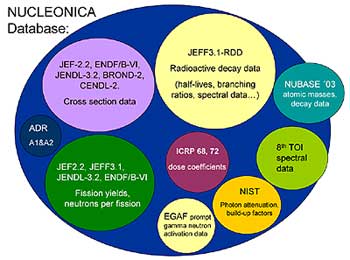
Fig.2. Structure of the NUCLEONICA database.
To support the nuclear science applications in Nucleonica, the database is further complemented by a variety of data supplied by various sources:
spectral data (energies, emission probabilities etc.) from JEFF3.1. In addition, spectral data from the 8th table of isotopes [6] can be selected for comparison and for library creation for gamma spectroscopy.
photon mass attenuation coefficients and the mass energy-absorption coefficients from the National Institute of Standards and Technology [7].
build-up factors, to model the scattering effects in the shield material for the dosimetry module which have been taken from [8].
prompt gamma ray activation data [9] for thermal neutron activation analysis.
fission yield data from the main international datafiles: JEF2.2, JEFF3.1 [4], JENDL-3.2 [10], and ENDF/B-VI [11,12].
integral cross section data from JEF Report 14 [13] which contains averaged neutron cross-sections from international datafiles JEF-2.2, ENDF/B-VI, JENDL-3.2, BROND-2, and CENDL-2.
effective dose coefficients for ingestion and inhalation, e(50), have been taken from the International Commission for Radiological Protection compilation [14].
the A1 and A2 activity and activity exemption limits for packaging and transportation [15].
properties of the elements [16] (densities, melting points, boiling points etc.).
tables of physical constants and conversation factors [17]
miscellaneous tables to manage user data.
The NucleonicaWiki [2] allows the development team to add, remove, edit and change content on the portal using wiki technology - an approach which is extremely flexible. The NUCLEONICA administrators can determine which parts of the portal can be updated and by whom. Certain parts of the portal will only be accessible to the administrators. Wikis are not only restricted to the online manual but can be used for adding articles and links, discussions groups etc. This will allow NUCLEONICA to grow organically and provide a powerful nuclear science collaboration platform for its users.

Fig.3. The NucleonicaWiki: Wiki-based online user manual.
The courses introduce the basic concepts of nuclear science and technology and are suitable for participants from the nuclear industry, nuclear research organizations, universities, regulatory authorities and nuclear medicine institutes. Core topics range from the history of radioactivity, nuclide charts, the Karlsruhe nuclide chart [18], radiation protection and health physics through to the storage and transportation of radioactive materials. Recent exciting developments in nuclear science are highlighted in a series of special topics covering nuclear forensic science / illicit trafficking, nuclear science with high intensity lasers, environmental radioactivity, radiation hormesis and the LNT hypothesis, etc. Lectures are be followed by a series of “hands-on” case studies based on the use of the Nuclides.net / NUCLEONICA web-based applications to give the user direct experience in the above areas.
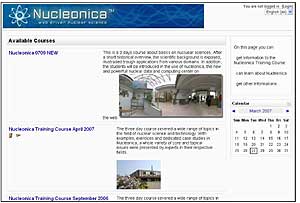
Fig.4. The NUCLEONICA e-learning platform blends internet
technology with traditional teaching methods.
The NUCLEONICA web site: www.nucleonica.net
KORIGEN see: U. Fischer and H. Wiese, ORNL-tr-5043, 1983 also KfK 3014. For webKORIGEN in NUCLEONICA see: www.nucleonica.net:81/wiki/index.php/Help:WebKORIGEN
NucleonicaWiki: see www.nucleonica.net:81/wiki/index.php/Main_Page
A. Koning et al., "JEFF Report 21: The JEFF-3.1 Nuclear Data Library", OECD 2006.
G. Audi et al., Nuclear Phys. A 729 (2003) 3-128. (amdc.in2p3.fr/web/nubase_en.html)
R.B. Firestone, "Table of Isotopes, 8th edition", John Wiley & Sons Inc., (New York, updated in 1998).
J. H. Hubbel and S.M. Seltzer, Radiation Research 136, 147 (1993),
website at:
physics.nist.gov/PhysRefData/XrayMassCoef/cover.html
“American National Standard for gamma-ray Attenuation Coefficients and Buildup Factors for Engineering Materials”, ANSI/ANS-6.4.3-1991 (1991).
R.B. Firestone, et al., “The Evaluated Gamma-ray Activation File (EGAF)”, CP769, International Conference on Nuclear Data for Science and Technology, American Institute of Physics, AIP Conference Proceedings Volume 769, 2005.
T. Nakagawa et al., J. Nucl. Sci. Technol., 32, 1259 -1271 (1995).
T.R. England and B.F. Rider, “Evaluation and Compilation of Fission Product Yields”, LA-UR-94-3106 ENDF349 (1993).
P.F. Rose, "ENDF/B-VI summary documentation", Report BNL-NCS-17541 (ENDF-201) (1991).
“JEF Report 14: Table of Simple Integral Neutron Cross-Section Data from JEF-2.2, ENDF-BVI, JENDL-3.2, BROND-2 and CENDL-2”, OECD 1994.
Age-dependent Doses to Members of the Public from Intake of Radionuclides: Part 5, Compilation of Ingestion and Inhalation Dose Coefficients, ICRP PUBLICATION 72, Annals of the ICRP, 26 (1996). Pergamon Press.
15. ADR (from Accord Dangereuses Route)
en.wikipedia.org/wiki/European_Agreement_concerning_t
he_International_Carriage_of_Dangerous_Goods_by_Road
Handbook of Chemistry and Physics on CD-ROM, version 2006, D.R. Lide (Editor), CRC Press, Boca Raton, Florida, September 2005.
17. P. J. Mohr and B. N. Taylor, Rev. Mod. Phys. 77 (2005), 1.
http://www.euronuclear.org/e-news/e-news-17/nps-kth.htm

In Sweden an innovative reactor design was developed during
the past decades. A reactor for district heating SECURE and a reactor for
production of electricity PIUS (Process Inherent Ultimate Safety)
SECURE and PIUS are innovative light water cooled reactors with passive
safety systems in a large pool of borated water in a concrete pressure vessel,
located underground. The irradiated fuel can be stored inside the reactor
cavity for thirty years. These features make the concept actual for today’s
requirements.
An electrically heated test loop was built where the basic design characteristics were successfully verified. The concept was analyzed through detailed calculations with different computer codes.
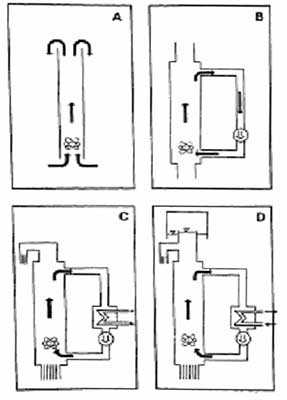
Figure 1. The Operating Principles of the PIUS Pimary System
| A. |
A heat source (nulcear core) placed in a vertical pipe
in a water pool will cause an upward flow in the pipe. |
| B. |
If the heated water is returned to the lower end of the pipe there
is no net flow from and to the pool. |
| C. |
The heat generated can be extracted for a useful purpose. Mixing
between hot circulated and cold pool water is prevented by stable
stratification in tube bundles (density locks) |
| D. |
By placing the pool in a closed vessel and pressuring with a steam bubble above the circulation system the latter can be operated at high pressure and temperature. |
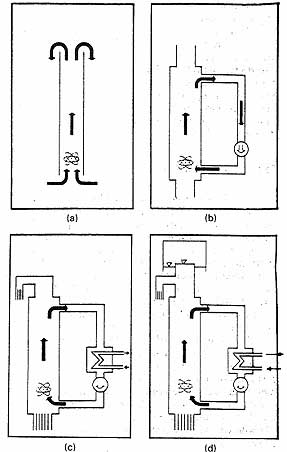
Figure. 2 The operating principles of the SECURE primary system.
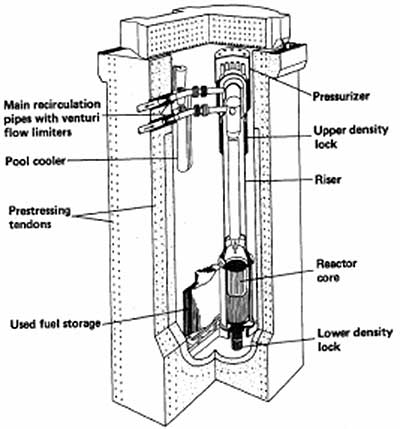
Figure 3. Heated Reactor Secure-H and Prestessed Concrete
Vessel. Main Features of Nuclear Island.
400 MWth, 2 MPa, exit temperature 190 0C
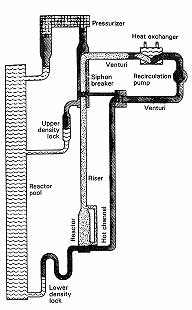
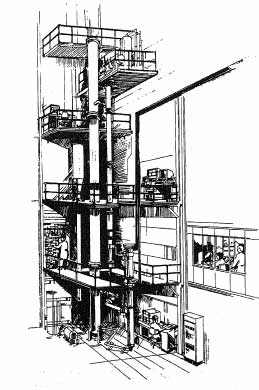
Figure 5. The ATLE test rig.
|
National Heat Conference |

Fig 6. Schematic of the PLUS Reactor.
Same as Nuclear Safety article, Fig. 1, LA-UR-94-3467.
www.ornl.gov/info/reports/1991/3445603211254.pdf
September 1991
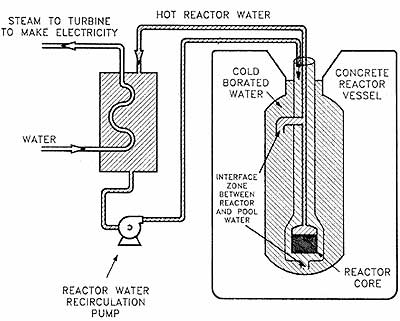
www.analys.se/lankar/bkgr/bkgr1-99.pdf

http://www.euronuclear.org/e-news/e-news-17/underground-reactors.htm

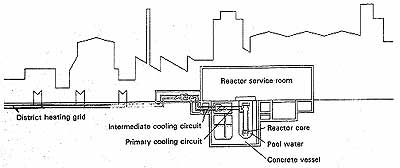
Fig. 1: The SECURE-H main cooling system
www.mobergpublications.se/energipolitik/appendix2.htm
1970
(48) MARS: Krister Wickman tillsatte närförläggningsutredningen.
Bakgrunden var att Stockholms elverk i
juli 1968 sökt tillstånd för ett kärnkraftvärmeverk
vid Värtan. Utredningen skulle ta fram ett underlag
som underlättade myndigheternas ställningstaganden till tillståndsärenden
av detta slag. Utredningen var i princip positiv till närförläggning.
När betänkandet (Ref. 56) kom i juni 1974 var emellertid det politiska
läget för kärnenergin ett annat än då utredningen
tillsattes drygt fyra år tidigare.
The need for an investigation of safety questions arising in connection with the siting of nuclear power plants in and close to major population centres was brought into focus in 1968. The occasion was the application by the Electricity Supply Authority of Stockholm for permission to erect a nuclear combined power and district heating plant at Värtan which is located only a few kilometres from the central part of Stockholm. At that time, certain other projects involving nuclear combined heat and power plants on urban or near-urban sites were also being discussed.
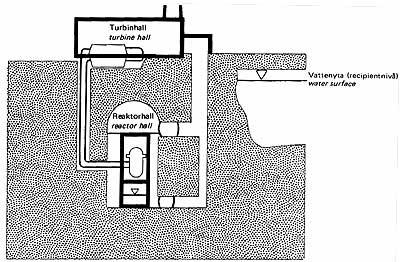
Fig. 2: REAKTOR DJUPFÖRLAGD I BERGRUM, TURBIN OVAN MARK
I NORMALNIVA
reactor in deep rock contaiment, turbine in above ground building at normal
level in relation to water recipient
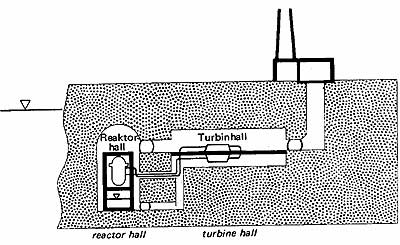
Fig. 3: REAKTOR OCH TURBIN I DJUPFÖRLAGDA BERGRUM UNDER
NORMAL NIVA
reactor and turbine in deep rock containmemt and below normal level in relation
to weater recipient
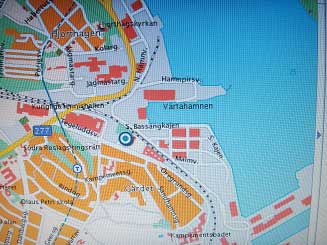
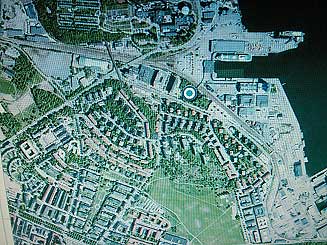



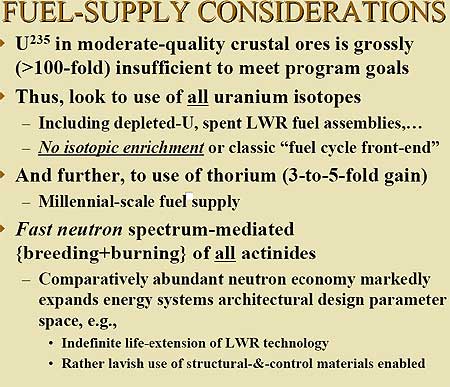
http://www.euronuclear.org/e-news/e-news-17/tractebel.htm

From 13 - 16 May 2007, ICAPP 2007, the International Conference on Advances in nuclear Power Plants, took place at the Acropolis conference centre, in Nice (France). The theme of the conference was The Nuclear Renaissance at Work.
Tractebel Engineering was present at the Suez stand, where the nuclear activities of the Group were exhibited under the theme Nuclear Expertise in the Energy Mix.
Six people from Tractebel Engineering’s Nuclear Division also participated in the plenary and technical sessions throughout the three days. They were also present at the stand providing information to visitors.
On the evening of 15 May, the conference’s official Gala Dinner took place, which was partly sponsored by Suez. A number of VIPs from the nuclear VIPs attended. Olivier Grosfils, head of Marketing & Sales, Tractebel Engineering, Nuclear Division, then took the floor and spoke on behalf of Suez.
Tractebel was present at the conference in a variety of other ways:
On 14 May, Jean Van Vyve, Executive Vice-president, Tractebel Engineering, Nuclear Division, presided a session on Advanced Power. After that, he presented a paper at a plenary session entitled Energy Challenges: the utility point of view.
On 15 May, Walter van Hove, Principal Engineer, Tractebel Engineering, Nuclear Division, presented a paper in entitled Supercritical Light Water Reactor with Intermediate Heat Exchangers.
You can consult these document by clicking on the following link:
![]() Abstract
Paper: SuperCritical Light Water Reactor (SCLWR) with Intermediate Heat
Exchanger (IHX)
Abstract
Paper: SuperCritical Light Water Reactor (SCLWR) with Intermediate Heat
Exchanger (IHX)
http://www.euronuclear.org/e-news/e-news-17/brossele.htm

Borssele is a two-loop PWR built by Siemens KWU, that became operational in 1973. It is operated by the Dutch utility EPZ, which over the years has invested regularly in safety and efficiency. After its first PSR a plant modernisation programme of around 250 million Euros has been implemented in 1997 during a five-month outage. Highlights included the back fitting of new primary safety valves, new steam and feed water lines, a new control room, an emergency control room, new emergency diesel generators with higher capacity and a reserve ultimate heat sink.
In 2004 EPZ has decided to improve the plant’s balance of plant to a gross capacity of 510 MWe (see e-news issue 15, winter January 2007). This was carried out by Siemens during the 2006 outage.
In the same outage also the majority of measures were implemented that followed from the second PSR. These improvements have resulted in another significant gain in nuclear safety (see figure 1).
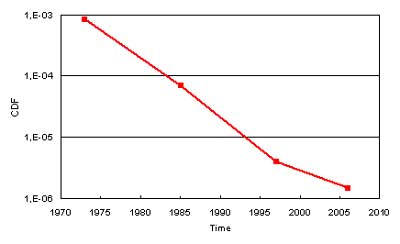
Figure 1. Changes in total core damage frequency as a result
of safety improvements.
This paper reports on the process of the latest periodic review, as well as on examples of implemented measures. The associated gains, in terms of nuclear safety, are seen as the first priority for EPZ. At the same time these gains contribute to our goal of staying in the top of the safest nuclear power plants in the western world.
The operating license of the Borssele power plant stipulates that EPZ should conduct and report a periodic safety review every 10 years. This PSR is extensive and analyses developments in technology and regulations with respect to the current licensing base. The periodic safety reviews cover both design and operation, with technological-, organisational-, personnel- and administrative aspects.
The most recent PSR covers the period 1993 – 2002 and consists of an evaluation-, a conceptual- and an implementation phase. An important result of the evaluation phase was that Borssele is operated safely, in compliance with (inter)national regulations and current state-of-the art technology. In addition, several areas for further improvement and optimisation have been identified. The improvements have been selected, amongst others, for their impact on the total core damage frequency contribution (TCDF, PSA Level 1) and on individual risk contribution (PSA Level 3). This was calculated with the full scope, plant-specific living probabilistic safety assessment model. In figure 1 the integrated effect of these improvements on the total CDF is given. It shows that the most recent periodic safety review has resulted in another significant gain, despite the 1985 and 1997 back fitting projects which already reduced the original total CDF number significantly. An important decision has been to increase the so-called mission time in the PSA from 24 hours to 72 hours. This has allowed us to identify areas of improvement beyond the original 24 hours after the occurrence of an event. It has turned out that for some rare external events a significant safety improvement could be achieved.
The evaluation of subjects for improvement started in 1999 by gathering information from different sources, such as:
Input from personnel (listening to own organisation)
Assessing new and upcoming regulations (national, KTA and IAEA)
Information from aging programmes (conceptual and physical)
Probabilistic Safety Analyses (In house living PSA model, as well as know-how of commercial companies in the field of PSA)
Over more than 1200 issues were gathered and clustered in 26 basic reports. After a first evaluation 176 issues of potential improvement were selected, based on know-how and PSA data.
The potential improvements were further analysed during the conceptual phase, and measures were formulated in order to obtain the improvement. An estimation of costs was made together with the expected benefits, which were selected on expected gains in nuclear safety and based on:
Probabilistic information.
Impact on the total core damage frequency (CDF) and the individual risk
were calculated with a plant-specific living probabilistic safety assessment
model.
Deterministic information.
Upcoming regulations and defence-in-depth approaches (failures, availability,
reliability,..) was analysed.
Radiation protection gain.
Collective, individual and environmental doses were calculated.
The issues for improvement were split into Technical (design) measures and OPA measures (organisational, personnel and administrative measures). All measures were subject to a cost/benefit analysis, and the end result has been agreed upon by the regulator in June 2005.
The modifications resulting from the technical measures were conducted by a separate project organisation. It covered around 35 measures of which 20 measures were conducted by own personnel. The remaining 15 measures were carried out by the consortium Belgatom – GTI on a design & construct basis. Within this consortium Belgatom was responsible for the project management, the nuclear engineering and the final testing. Detail engineering, purchasing and construction was carried out by GTI.
The engineering process and (safety) evaluation by personnel took place in 2005 and first half of 2006. Some of the measures required a change in the operating license. This was honoured in the beginning of 2006. Therefore, construction could start in the second half of 2006, and was concentrated in the outage of 2006. In 2007 some smaller constructions are finalized and documentation is completed. In the following paragraphs some examples are given, showing the diversity of the implemented measures.
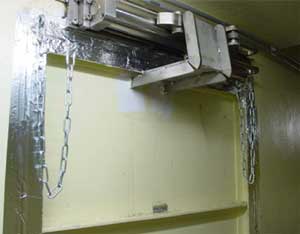
Figure 2. Remotely opened explosion hatches.
Several defence in depth measures were formulated that cover different lines of defence, i.e. from prevention of system failures to extending the design basis of the plant. Examples of these measures are the installation of new improved seals of the low pressure safety injection pumps, an additional feeding possibility of the back-up decay heat removal system with a fire pump, installation of an additional pump in the cooling circuit for the irradiated fuel storage pond, and an additional pump for the emergency residual heat removal system.
Furthermore, the installation of a connection between the two emergency grids (6kV – 400 V) and extending battery power have been carried out. The power supply of the reactor protection system is extra secured and the dependence of the external grid has been further diminished, resulting in a significant gain in CDF.
As a last example, remotely opened explosion hatches have been installed (see figure 2). Between the operating- and the innercontainment section of the reactor building there are explosion hatches, which are designed to burst open in case of accidental pressure build-up, so as to limit damage to the innercontainment. In case of a very small LOCA with hydrogen buildup, the explosion hatches at top and bottom of the steam generator sections can now be opened remotely from the control room. In this way an air flow is forced by means of a chimney effect. The hydrogen will mix and reach the passive recombinators at the different positions in the reactor building.
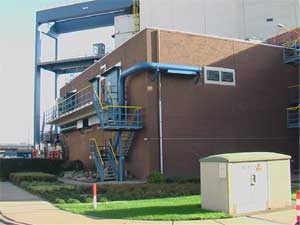
Figure 3. Air intake of bunkered diesels.
In a periodic safety review also off-site events are assessed that could influence the plant’s safety. Increased traffic of LPG tankers on our river have led to installation of igniters for external flammable clouds. More severe storms and sea level increase, due to a possible climate change, has led to an even more conservative design level of external flooding. The air intakes of the bunkered diesels were placed higher up with an external structure attached to the bunkered building (see figure 3). Because of the safety function, the pipework is earthquake-proof, blast-proof and on different sides of the building to reduce common mode failure.
Also a crashtender (see figure 4) was acquired to be able to fight kerosene fires that would challenge vital buildings.
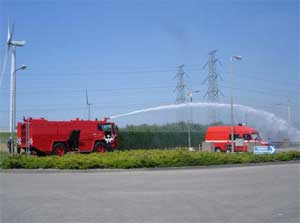
Figure 4. Crashtender for fighting kerosene fires.
http://www.euronuclear.org/e-news/e-news-17/bulgaria.htm

The Bulgarian Nuclear Society welcomes the fact that all Bulgarian citizens are now citizens of the European Union. To our deepest regret, however, the power of civil society has not proved to be enough to change people’s thinking and our country has paid for its EU membership with the shutting down its most efficient, economically viable and cheapest source of electricity generation – units 1-4 of the Kozloduy NPP.
At the same time, the European Commission proposes to the European Council and the European Parliament a long-term energy strategy, based on significant reductions in greenhouse gas emissions and the more effective use of the energy resources. This is the finalization of a long development process that started with publishing of the Green Book on energy sustainability in the EU. This new strategy, although not advantageous for nuclear energy, recognizes the real benefits it has when it comes to solving energy supply problems.
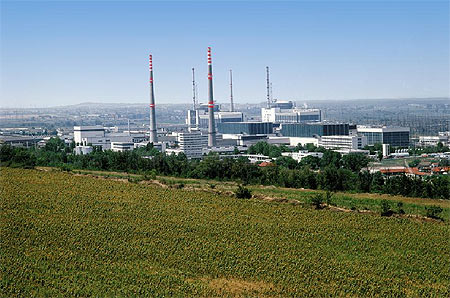
Kozloduy NPP - units 1-6
The shutdown of Kozloduy’s Units 3 & 4 seriously undermines EU energy policy goals and principles. It also seriously compromises Bulgaria’s national interest. And what’s more, the decision was made for purely bureaucratic reasons.
The following programmes for the modernization of units 1-4 have been carried out:
Period 1991-1996: Cost: 145 million US$; Number of design project changes - 984
Period 1997-1999; Cost: 100 million US$; Number of design project changes - 468
Period 2000-2002; Cost: 66 million US$; Number of design project changes - 375
Period 2003-2005; Cost: 14.3 million €; Systems for severe accident management
Period 2003-2005; Cost: 22.5 million€
Bulgaria is the first country that has an official confirmation from the AQG (Atomic Questions Group of the European Council) that implementing the recommendations were “necessary to achieve and maintain a high level of nuclear safety.”
Kozloduy NPP is the most reviewed and controlled nuclear power station in Europe and probably in the world, as the following timetable shows:
1990 |
IAEA ASSET 1-4 |
1991 |
IAEA SRM 1-4 and IAEA OSART 5 |
1992 |
WANO PERMANENT MISSION 1-4 |
1993 |
IAEA FOLLOW-UP ASSET 1-4 |
1994 |
IAEA ASSET 1-4 and IPERS 5&6 |
1995 |
WANO PEER REVIEW 5&6 and G-24 MISSION, BENCHMARK MISSION |
1996 |
IAEA IPPAS 1-6 |
1997 |
IAEA ASSET 1-6 and IAEA MISSION EMERGENCY PROC. 5&6 |
1998 |
IAEA PRE-OSART 1-4 |
1999 |
IAEA OSART 1- 4; WENRA 1-4 & IAEA MISSION EMERGENCY PROC. 1-4 |
2000 |
IAEA REVIEW 5&6 MODERNIZATION PRG and IAEA REVIEW 3&4
RECONSTRUCT. PRG |
2001 |
IAEA FOLLOW-UP OSART 1-4 and IAEA REVIEW KNPP ORG. STRUCTURE |
2002 |
IAEA IPPAS 1-6 and IAEA SRM 1 – 4 |
2003 |
WANO PEER REVIEW 3&4 and AQG PEER REVIEW 3&4 |
The conclusions of the safety review teams have always been positive with regard to Kozloduy NPP.
Furthermore, the IAEA Annual Report for 2002 said the following:
"A Safety Review Mission to Kozloduy, in Bulgaria, reviewed the results of more than a decade of safety upgrades and assessments at units 3 and 4, including a series of actions recommended by various IAEA Review Teams.
The Team concluded that operational, seismic and design safety at Kozloduy now corresponds to the level of improvements seen at plants of similar vintage elsewhere.
Many of the safety measures adopted for these plants in the design, operation and seismic areas exceeded those that were foreseen. “
Bearing in mind the reality of the current situation, the Bulgarian Nuclear Society insists that the Bulgarian government take the necessary steps with the European institutions to review this humiliating clause in the agreement reached between the EU and the Bulgarian government. The premature decommissioning of the units 3 and 4 of the Kozloduy NPP was an unwise move and will prove detrimental to the whole EU in view of increased energy demand in the Community.

On 31 December 2006, Kozloduy NPP observed the Bulgarian Council of Ministers decision of 21 December 2006 to shut down units 3 and 4.
http://www.euronuclear.org/e-news/e-news-17/genitron.htm


With the help of the European Union’s Tacis programme the SSSIE EcoCentre, the State Specialized Scientific and Industrial Enterprise, located in Kiev (Ukraine) is upgrading the automated monitoring system around Chernobyl’s 30 km Exclusion Zone. The contract awarded in December 2005 to the consortium of Ukratom Instruments of Ukraine and Genitron Instruments covered a complete overhaul involving the use of 39 new GammaTRACER radio dose rate sensors, 9 new aerosol samplers and the SkyLINK radio system to replace an old wire communication system. A software application for dispersion modeling was also used.
Genitron provides the complete data management
system into which data from the other sensors are also integrated,
including a meteorological station supplied by Genitron. Factory
Acceptance Tests were performed at Genitron during August 2006. Twenty-one
system probes of were installed at the Chernobyl site in December
2006. The complete project was finalized in June 2007. Even probes
installed behind the shielded sarcophagus give good reception even
at a distance 16 km distance. With the following link you can take
a look at some of the existing probe installations:
www.uap.fphosting.de/images/montage/photos.htm
|
Contact: SSSIE EcoCentre, Dr. Oleg Bondarenko, e-mail: boa@ecocentre.mns.gov.ua. Photo: Factory Acceptance Test with SSSIE and Ukratom Instruments at Genitron, Frankfurt, August 2006 |
In the GammaTRACER reference brochure a complimentary letter can be found dating back as far as 1994. Ever since then, German company VKTA (Nuclear Technical Procedures and Analysis), based in Dresden, has been using the GammaTRACER probe with infrared readout. In autumn 2006, a contract was signed for the upgrading of the safety using Genitron’s ShortLINK radio system. This was chosen to provide a more flexible and comfortable use of a number of applications that VKTA carries out. The new system was installed in December 2006.
Contact: VKTA Verein für Kernverfahrenstechnik und Analytik, Rossendorf e.V., Dresden, Dr. Andreas Beutmann, phone 0049-260-3448
New regulations for emergency management systems brought in by the Swedish SSI (the national safety institute) for Sweden’s nuclear power plants lead to the installation of Genitron’s GammaTRACER / ShortLINK radio systems. For the different threat categories plants are obliged to install monitors in premises that may be manned in an emergency situation for a prolonged time, in the reactor containment area and in chimneys or exhaust pathways. This is done in order to measure radiation levels that might occur in the event of severe damage to fuel systems. Equally, the measurement of external radiation outdoors has to be assured within the facility area and in close proximity to the plant.
For applications where fixed and mobile stations around the complete land space are required, the GammaTRACER autonomous probe concept working alongside the proprietary ShortLINK radio system turned out to be the ideal solution for covering these requirements in a cost-efficient and timely manner. According to the users, in practice a wired approach could not have been realized within the short time frame imposed by the SSI. Although official contracts were only received during October 2006, Genitron managed to fulfill all requirements for operational systems based on user allocated frequencies before the end of December, which was required by the regulations. The installations consist mostly of fixed but also flexibly handled probe set-ups within the 5 km range around each individual power plants.
Factory Acceptance Tests and training for the three plants had taken place at the end of November, followed by site installations in December 2006. At Forsmark 7 GammaTRACER radio probes were installed, at Ringhals 8 and at OKG 11. They were installed on December 2006. The latter contract was awarded to Genitron’s French mother company Saphymo.
Contacts:
Ringhals AB, SE-430 22 Väröbacka, phone: 0046-340-66 88 18, Mr.
Lars Ekengren, Project Manager, e-mail: lars.ekengren@ringhals.se
Forsmarks Kraftgrupp AB, SE-74203 Östhammar,
Mr. Richard Gliegel, Project Manager, phone 0046-173-82557,
e-mail: 5sv@forsmark.vattenfall.se
OKG Aktiebolag, SE-572 83 Oskarshamn, Mr. Bo Nilsson,
Project Manager, phone: 0046-491-78 61 95, e-mail: Bo.B.Nilsson@okg.eon.se
|
|
http://www.euronuclear.org/e-news/e-news-17/sfen.htm


At the French Nuclear Society’s (SFEN) General Assembly, in Paris, on 20 June, the traditional “Grand Prix” for scientific excellence was awarded to the joint CEA/EDF team that runs the Pheonix rapid neutron type reactor. Joel Guidez and Jean Guihard received the prize on behalf of the CEA and EDF respectively. The prize was awarded in recognition of the excellent operating performance of the Pheonix reactor, which has enabled the carrying out of irradiation experiments that are necessary to further research into the management of radioactive waste. One of the main elements that contributed to the excellent performance of the Pheonix reactor that the SFEN jury particularly praised was the excellence of the safety review that the plant’s team carried out between 1994 and 2003. The review’s success was, in the view of the jury, down to the close collaboration between the CEA, EDF, AREVA-NP (formerly Framatome) and their respective sub-contractors.
The Pheonix NPP in Marcoule began operating in 1973 and has maintained a remarkable level of operation, amply justifying the faith that experts had shown in fast neutron type reactors. Conformity with the objectives of the law of 31 December 1991 (relating to research into waste management, with special reference to “research into solutions that allow the transmutation of certain long-life radioactive elements present in radioactive waste”) required the launching of an irradiation research programme. This was originally to be carried out in the Super Pheonix. However, the premature closure of the Super Pheonix reactor resulted in the CEA asking for an operational extension of the Pheonix reactor so that it could take over responsibility for the irradiation testing programme. The Pheonix reactor fully lived up to expectations, proving to be a high-performance unit – not only with regards to fulfilling the requirements of France’s national research programme, but also for the experiments it carried out within an international collaborative framework.
The experiences gained from this programme will undoubtedly be beneficial for the promotion of worldwide research into radioactive waste management techniques.
Among the other prizes awarded at the SFEN General Assembly were the “Jacques Gaussens” Prize, which is awarded by the nuclear industry to young researches in recognition of a significant contribution made by a research study or thesis in a given field. This year the prize was awarded to Jean-Philippe Mathieu for his thesis entitled Analysis and micro mechanic modelling of the behaviour and fragile rupture of steel 16MND5, taking account its micro-structural homogeneity.
This year’s “French Atomic Forum (FAF) Prize,” which recognises the contribution that a study in nuclear energy can make to raising the knowledge and awareness level of the public, went to Philippe Bronsart and Alexandre Viet, for organising (in Aixe-en-Provence, in October 2006) a seminar entitled What does the future hold for nuclear energy?contribution that a study in nuclear energy can make to raising the knowledge and awareness level of the public, went to Philippe Bronsart and Alexandre Viet, for organising (in Aixe-en-Provence, in October 2006) a seminar entitled What does the future hold for nuclear energy?
Finally, the “Jean Bourgeois Prize,” which rewards the most valuable thesis dealing with the subject of safety at nuclear installations, was awarded to two people:
Christian Muin, for his thesis entitled Study of the behaviour of the fissile product ruthenium within the confinement area of a nuclear reactor in the event of a serious accident, which he wrote while working at the IRSN (French Institute for Nuclear Safety). The theses was co-financed by IRSN, EDF and the CEA. |
|
and
Isabelle Ramière, for her thesis entitled Fictitious methods of analysing elliptical problems bearing in mind general limitations with regards to the numerical simulation of di-phasic leaks. The thesis was completed within the framework of a Neptune Project carried out in collaboration with the CEA, EDF, AREVA-NP and the IRSN.
http://www.euronuclear.org/e-news/e-news-17/iync-2008.htm

The International Youth Nuclear Congress (IYNC) 2008 will be held in Interlaken, Switzerland, from 20-26 of September 2008. There have already been four successful IYNC conferences held around the globe - with delegates convening in Slovakia (2000), South Korea (2002), Canada (2004) and Sweden/Finland (2006). The recent congress in Stockholm attracted over 350 professionals from 48 countries!
In 2008, the biannual congress will take place in the stylish Kursaal Conference Center of Interlaken, which was built in the middle of the 19th Century. Surrounded by an attractive park and equipped with modern infrastructure this location is a leading congress venue in Switzerland. Interlaken, a beautiful Swiss small town with an international flair, is situated in the centre of Switzerland, between the Lakes of Thun and Brienz and at the foot of the famous peaks of Eiger, Mönch and Jungfrau.
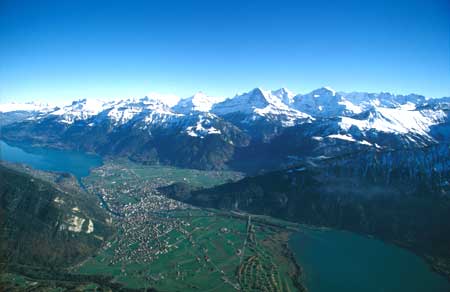
The town itself enjoys a central location. Railways and highways connect Interlaken with the airports of Zurich (177 km), Geneva (230 km), Basel (138 km) and Berne (57 km), and also with the most important cities of Switzerland and foreign countries.
The conference programme for IYNC 2008 centres around four
technical thematic sessions - Nuclear Science & Technology, Nuclear
Waste & Decommissioning, Non-Power Applications and Nuclear Politics
& Economics. In addition to the technical programme an extra thematic
session to discuss the young generation and IYNC activities is foreseen.
Contributions to IYNC 2008 will be either as oral presentations or poster
sessions. All accepted papers presented will be published in the IYNC 2008
conference proceedings.
The technical programme will include visits to nuclear research facilities, Swiss nuclear power plants, facilities for nuclear waste disposal and the Grimsel test site for the final disposal of radioactive waste.
The executive committee is looking forward to welcoming you to IYNC 2008. See you in Interlaken!
Dr. Marco Streit
General Co-Chair & Local General Chair IYNC 2008
Bahnhofquai 12,
CH-4601 Olten
mailto: marco.streit@iync.org
http://www.euronuclear.org/e-news/e-news-17/czech-young-gen.htm

On 1 April 2007, an overcast morning and bitingly cold wind has chased one’s hands into the safety of warm pockets. In spite of this ten intrepid Czech “youngsters” met at 8.30 at the entrance to the Škoda JS factory – at Bolevec near the famous Czech city of Pilsen. We were welcomed there by Dr. Václav Bláha, Vice President of the Czech Nuclear Society, who was our guide throughout the visit to Škoda JS that day.
First we were introduced to the history of the Bolevec area. At the turn of the 19th and 20th century it served as a testing ground for all kinds of weapons that the Škoda company manufacturzed. Even by now there are supposed to be unexploded munitions buried below several meters of ground somewhere in the area. It started being used for the nuclear industry in the second half of 20th Century. Škoda JS is in fact the successor of the company Power Plant Construction, which was founded in 1955 and has played a key role in the development and construction of the Czechoslovakian design heavy water moderated and gaseous CO2 cooled power plant, A1, in Jaslovské Bohunice (150 MWe, operational between 1972-1977 and closed due to an accident classed 4 on the INES scale). Later on it also played a significant role in the construction of Soviet-type light water reactors (WWER) that were used all over central Europe. At present, the main operations at Bolevec are concentrated in two buildings –the so called “Light Hall” and the Experimental Hall.
In the Light Hall we were greeted by the Head of Operations, Miroslav Hejda, who explained the origins of the Hall’s name – the word “light” refers to its manufacture of products weighing less than 5 tons. At present these are namely linear step drives for control organs for reactors WWER-440 and WWER-1000, pins for carrying the CASTOR spent fuel containers and the non-nuclear parts of the nuclear fuel for WWER-1000 (fuel assembly heads and bases) for Westinghouse. The Light Hall was built 15 years ago and it is a very modern factory. The construction material used for most of the products is austenitic steel precisely machined on numerical-controlled lathes. Machined parts are then welded on special workplaces. Pride of place in the factory goes not only to the Japanese NC-lathes “Mazak”, but also to a device for electron-beam welding. Surfaces of the welded metal joint are heated inside a vacuum chamber under bombardment by electrons that are accelerated by 60 kilovolts at currents reaching up to 250 milliamperes (the maximum input is, therefore, 15 kW). The process can be seen through a lead-glass partition to protect staff from fast electron induced X-rays. This clean way of welding without any additional welding components makes it possible to weld parts up to 4 cm in depth (from one side – welds from both sides allows welds of up to 8 cm deep). It masters the welding of most metals and is very useful for welding high carbon-content steels (max. 22 % C). However, it can not weld zinc as it quantitatively evaporates in the combined high temperature/low pressure conditions. After welding the products are transferred into the assemblage hall, where they are de-greased and tested for flaws – especially their welds. The employed testing techniques include¬ ultra-sound, X-ray and magnetic fluorescence analyses. At the end of the process the finished products are displayed on stands prepared for the customer.
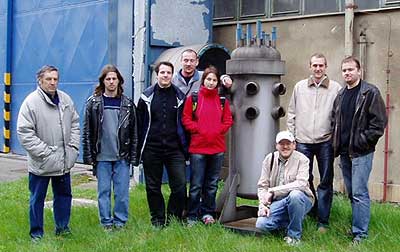
Czech YG members assembled in front of the Škoda JS
Reactor Hall, around a symbolic model of a VVER-440 reactor vessel that
was produced there on many occasions.
Next Dr. Bláha showed us the Experimental Hall which was originally used for the gas cooled programme of the heavy water moderated A1 reactor. Because of its earlier function it is no less than 24 meters high to be able to house the long gas channels. However, the gas programme was cancelled (not only due to political reasons) in 1968 and, in connection with the light-water programme, a water-circuit adapted to the parameters of a WWER-1000 reactor was installed there. It has been used, e.g., for testing control rod drives under real operation thermo hydraulic conditions. In addition to the water loop, an independent sodium loop was installed in the Experimental Hall as part of the fast reactor research programme, but it never actually was operational. In the 1990s, hexagonal fuel assemblies made by Westinghouse for the Temelín NPP (2 x WWER-1000) were intensively tested, particularly for heat-transfer crisis – a phenomenon that causes rapid fall of heat-transfer from the over- heated fuel rod to the cooling medium due to the formation of a thin vapour film on the surface of the cladding. New tests are currently being planned in connection with the change of the Temelín NPP’s fuel supplier from Westinghouse to the Russian firm TVEL.
After visiting the Experimental Hall we headed south by car from the wooded Bolevec area into the factory-grounds of the originally jointly-owned Škoda company, which is located in the Pilsen city centre. Within the cluster of factory buildings the companies that took over from the old machinery-making giant are located. As we made our way through the labyrinth we passed the main factory of Škoda POWER, which manufactures turbines. However, we were also interested to visit Škoda JS’ second key manufacturing plant – the Reactor Hall. Head of Operations, Miroslav Nolc, explained that the building is 27 years old and its 40 meters tall and that the lifting-capacity of the strongest crane is 400 tons. In the past, the Hall produced WWER 440 and 1000 reactor vessels, but after the completion of Temelín NPP the nuclear programme slowed down and production was focused temporarily on reactor vessels for the chemical industry (with no lower requirements, one chemical reactor for ammonia production could run tests under a pressure about 50 MPa) and for CASTOR spent fuel containers.
As we passed through the Reactor Hall, we could see that production was devoted exclusively denoted to the nuclear power industry, because Škoda JS has been successful on the markets of Western Europe. IN addition to the production of CASTOR transport containers (the older type) for the Obrigheim NPP (Germany), we saw production linked to that “symbol of European nuclear renaissance” – the European Pressurized Reactor for Olkiluoto 3, in Finland.
Although the number of CASTOR containers being manufactured was high (in total 15), all the production process steps were demonstrated at each individual work-station. The 120 ton steel-iron cast in the form of a hollow cylinder that is closed at the bottom is supplied by the steel foundry of the Škoda Steel company. It is machined by first cutting inner steps for two hermetical lids. Vertical sample-drills are then made through the container walls (to test the metal’s homogeneity). If the analysis yields positive results, the whole diameter of the container is drilled with long vertical holes, in which special polyethylene rods will be inserted to slow down the fast neutrons arising from the spontaneous fission of higher transuranic elements contained in the spent fuel. After preparing the places where the carrying-pins are inserted, the flat surface of the cylinder is machined into characteristic ribbing to allow better heat-removal. Once all the mechanical adjustments have been made, the vessel is then galvanised with a 3-millimeter thick layer of nickel (during this process the vessel is filled with an electrochemical nickel-solution) for 7 days. After the internal nickel coating, the external surfaces are shot-blasted in a special container with an abrasive powder stream (and, therefore, de-greased) in order to make the protective varnish paint - which was blue in this case - stick better to the surface. Apart from the CASTOR containers, CONSTOR containers for the Lithuanian NPP Ignalina are also made in the Reactor Hall. These containers are different insofar as they are not just metal - the hollow space inside the metal double wall is filled with concrete.
The Hall has a variety of giant milling cutters and drilling machines for machining the metal products. We were primarily told that the boring mill schies capable of work with up to 10 meters large objects and about a giant automated welding machine (using welding flux). The machining modifications create mechanical stresses that have to be removed by heating – which is done inside one of the two giant electrical furnaces that reach temperatures of up to 800°C.
AREVA has chosen Škoda JS as a supplier for the internal parts of the EPR reactor vessel (European Pressurized Reactor, 4500 MWt, 1600 MWe). In the Reactor Hall we had, therefore, a chance to stand inside the steel neutron reflector of the squared reactor core – at that time it contained stacked, un-welded rings. We saw the inner reactor barrel and we observed the very slow circular precision grinding process carried out by one of the control rod stabilizing grids. In addition, we were also shown the welding of the reactor-supporting ring. The reactor pressure vessel itself is being manufactured in Japan, because the stringent requirements for low number of metal welds of such a great vessel increases the minimum metal ingot weight to levels that can be met only by the steel-works of Mitsubishi Heavy Industries.
We would like to give a special vote of thanks for the successful organization of the trip to Dr. Bláha and the Škoda JS company as the last part of our excursion in Pilsen was not to the Škoda factory but to the world-famous Plzenský Prazdroj a.s. brewery (although its name is more popular in its German version - Pilsner Urquell - that can be roughly translated into English as "The Headspring of Pilsen."). In the brewery, founded in 1842 as “The Citizens’ Brewery of Pilsen”, a professional guide – Mr. Hála – gave us a tour around the brewery and showed us roughly how Pilsner Urquell beer is brewed. He led us from a very nice Info center through a small gate into the factory itself. There a small mini-bus took us to the most modern part of the factory that was finished only this year – a bottling plant with a surface area of 2000 square meters! In this great hall, which cost over 1 billion Czech Crowns (35 million €) to build, there are lines for the control & removal, washing and filling of glass bottles (plus an extra one for filling alluminium cans, of course). The glass bottles are removed and re-melted after 3 or 4 cycles between the brewery and its customers. The bottling plant can produce over 60 thousand bottles a day, even though more than half of its space is no longer used and is awaiting possible expansion. In fact, only some of the bottles are filled with Pilsner Urquell beer. The plant also bottles other beer brands produced by breweries belonging to the Pilsner Urquell group (Gambrinus, Radegast and Velkopopovický Kozel).
Next we passed by an array of tall vertical cylindro-conical fermenting tanks, where the beer maturing process takes place, and the historical 46 meters tall water tower. Then we visited the newly-built brewery where the giant copper and stainless-steel kettles contain the “mash” (mixture of water and crushed barley malt) that then forms a fermentable liquid called “wort” (a water mixture of simple sugars generated by boiling off the starch from the barley grains). This is that is then mixed and boiled with hops, which give the beer its characteristic taste.
Finally, we visited the underground part of the brewery, which is not used nowadays except for a very small part where the company has preserved the historical way of maturing beer in cold cellars in wooden tubs and barrels. Under the brewery are large underground cellars that were mined out during the 19th Century. They once housed around 6 000 wooden barrels containing up to 30 or 40 hectoliters. The fresh (so called “green”) beer produced by 1 week of fermentation in opened tubs at temperatures slowly rising from 5 to 9 °C had been transferred into the great barrels, where it slowly matures into its final form over several months. When the maturing process is over, the beer was transferred into small beer barrels and distributed all around the country to the local pubs. At present, the brewery has 13 fermentation vats and 90 oak barrels – we were invited to test a specimen of this historical beer, which is different from the contemporary beers by its significant content of beer yeast. All presently mass-produced beers are filtered from the yeast (since the beginning of 20th century) and pasteurized (since the end of the Second World War). So, it was a memorable ending to a long day.
http://www.euronuclear.org/e-news/e-news-17/dutch-young-gen.htm

The European Young Generation Forum, a biannual conference that brings together young nuclear professionals, industry specialists and guest speakers from the world of politics and academia, was hosted this year by the Dutch Young Generation Network from 5 to 10 June 2007. It took place in that beautiful city synonymous with tolerance and diversity, Amsterdam. Over 80 participants from around 20 countries attended.
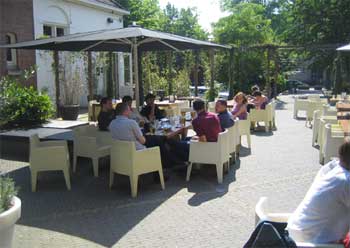
The former Dutch Prime Minister, Dr. Ruud Lubbers, kicked off the conference. He stressed the role that young nuclear professionals can play in promoting the economic and environmental benefits of their industry: “You are the young people who are looking to the future. Don’t be defensive and wait for politicians, take the lead on this issue yourselves.” Mr. Lubbers also expressed his strong conviction that renewables and nuclear energy were both necessary to tackle current energy issues. Professor van der Hagen, Director of the Reactor Institute in Delft, then gave an overview of the energy situation worldwide and in the Netherlands and underlined that no energy revolution was feasible without nuclear power.
Dr. Frank Deconinck, the President of ENS, encouraged young nuclear scientists to be open and transparent in order to increase the credibility of the nuclear community and to improve public acceptance of nuclear power.
The rest of the conference focused on various key issues including Generation IV, energy market liberalization, the hydrogen economy, public opinion and the media. The sessions featured speakers from the CEA (France), ADS, EnBW and Aara-Tessin (an energy service provider from Switzerland) and FORATOM.
A lively debate then took place between a nuclear advocate, Gerardo del Caz Esteso, from the Spanish parliament and Heleen de Coninck (from the Energy Research Centre of the Netherlands (ECN)), who believes that the risks posed by nuclear energy outweigh its advantages and that it’s better to invest in renewables and carbon capture and sequestration (CCS). The audience took part in the debate, which triggered discussions about which energy technologies are suitable to meet future energy challenges.
Juliette van der Laan, P.R. Manager at NRG (the Dutch national nuclear research institute, in Petten), delivered an interesting speech on how to deal with the media. She also stressed the need to be open and transparent with the media and to give them useful and concrete tips to the nuclear scientists who are nominated to talk to the Dutch television during the technical tour.
|
|
The young nuclear professionals then boarded a bus to Petten, to visit NRG’s facilities. The participants could visit either the High Flux Reactor (HFR) and the European Commission’s Joint Research Centre (JRC) Hydrogen Laboratories, or the Hot Cell laboratories and the ECN’s Renewable Energy Test Centre. The Dutch television channel NOS followed the group throughout the visit of the HFR and interviewed three representatives of EYGF - from the Netherlands, Spain and Finland respectively. The HFR, which is owned by the JRC and run by NRG-staff, is used for the research of materials used for fission and |
fusion, and also for producing isotopes for medical applications (www.nrg-nl.com). The programme was then broadcast during prime time hours.
The “fusion road show” was also “performed”
during EYGF. This show aims to explain the fundamental principle of fusion
in a clear and understandable way. It is based on the CD Fusion - Power
for Future Generations, produced by the European Fusion Development Agreement
(EFDA), which is available at:
www.efda.org/multimedia/cdroms.htm
EYGF was a great success and contributed to enhancing the profile of the nuclear community.
The programme and the presentations during the forum are available at: http://www.eyfg.org
http://www.euronuclear.org/e-news/e-news-17/nuclear-energy-overview.htm

http://www.euronuclear.org/e-news/e-news-17/nucnet-news.htm


20 Jun (NucNet): Areva has applied to UK regulators for pre-licensing of its European pressurised water reactor (EPR) design, saying its application is supported by major European utilities.
Areva said today its application is accompanied by letters of support from British Energy, EDF, E.ON UK, Iberdrola, RWE npower and Suez, who all consider the EPR to be a potential design for new build nuclear in the UK. Other major utilities have also expressed serious interest in the EPR, the company said in a statement.
Should Areva’s application be accepted, the three-year pre-licensing project will be jointly managed with EDF. This joint approach would bring together the combined strengths of a vendor and a potential licensee, Areva said.
The Olkiluoto-3 EPR unit in Finland is under construction and another is to be built at Flamanville in France. The EPR licensing process is also under way in the US.
Pre-licensing is now known in the UK as generic design assessment (GDA). The UK’s Health and Safety Executive (HSE) is hoping to start the first stage of the GDA process – the initial design assessment – in July 2007. This stage should be completed by early 2008.
The UK government is holding a consultation exercise on nuclear energy until mid-October 2007 and is likely to announce its final policy conclusions related to potential new build towards the end of the year.
The HSE says all nuclear related work, including generic
design assessment, is progressing “on a contingency basis” and
would be stopped if the government concludes it will not support the building
of new nuclear units.
>> Related reports in the NucNet database
(available to subscribers)
12 Jun (NucNet): Lithuania’s prime minister told a conference on the development of the energy sector in the Baltic states today that a new nuclear power plant planned for his country would have “huge strategic importance for the whole region”.
Gediminas Kirkilas told the Baltic Regional Energy Forum* in Riga, Latvia, that a draft law paving the way for the new plant is under discussion in Lithuania’s parliament and is expected to be adopted within the next few weeks.
Lithuania, Latvia and Estonia agreed in 2006 to collaborate in building the plant, saying it would be jointly managed by each of their respective national utilities. In March 2007, proposals were announced for Poland to join the project.
Mr Kirkilas said: “The project is still in a very early stage. At this moment in time we do not know how many and how large (the) reactors will be… an international tender shall answer these questions.”
Lithuania’s energy strategy for the period up to 2025 assumes the new plant will be operational from 2015 – a target which Mr Kirkilas said he believes is “ambitious but still reasonable”.
“In more global terms, I would like to stress that nuclear energy is one of the most realistic and commercially feasible alternatives to the traditional fossil fuels and could be instrumental in addressing the challenges of climate change. Lithuania opts for nuclear energy because it is crucial for our energy security and, dare I say it, our national security,” Mr Kirkilas said.
EU energy commissioner Andris Piebalgs, who is also attending the conference, said he supported a common energy agenda for the Baltic states. A statement issued by Mr Piebalgs did not refer to the joint nuclear power plant project but said he regarded the conference as an important step in forging a common energy agenda for the Baltics.
Mr Piebalgs also urged the Baltic states to continue to develop renewable energy sources and ensure that the potential of the region is fully exploited.
>> Related reports in the NucNet database (available to subscribers)
26 Jun (NucNet): Finnish power company Fortum today submitted its Environmental Impact Assessment (EIA) programme for the possible construction of a new reactor unit at the country’s Loviisa nuclear power plant.
Fortum said the programme was submitted to the Ministry of Trade and Industry. The company will now compile a formal EIA report based on the programme and Fortum hopes that report will be submitted to the ministry by the summer of 2008.
The EIA process is required before a possible application for a decision in principle to build the new unit, the third at Loviisa, which Fortum has said would have an electrical output of around 1,000 to 1,800 megawatts (MW), about 2,800 to 4,600 megawatts thermal.
Fortum said the programme was preparation for “the construction of new, climate-benign and domestic energy production”, adding: “Curbing climate change is one of society’s most critical challenges and to combat it, energy conservation as well as investments into renewable energy sources and carbon dioxide-free energy production, such as nuclear power, is needed.”
On 31 May 2007 another Finnish power company, Teollisuuden Voima Oy (TVO), submitted its EIA programme to the ministry for a possible new reactor at the Olkiluoto nuclear power plant. TVO’s EIA will also consider the construction of a 1,000 MW to 1,800 MW unit.
Meanwhile, a consortium of industrial and energy companies has formed a new Finnish power company, Fennovoima Oy, with the aim of pursing another project that could see a new reactor unit operational in Finland by 2016.
>> Related reports in the NucNet database (available to subscribers)
Links to Member Societies
|
| Austrian
Nuclear Society |
Belgian
Nuclear Society |
| British
Nuclear Energy Society |
Bulgarian
Nuclear Society |
| Croatian
Nuclear Society |
Czech Nuclear Society |
| Danish
Nuclear Society (DKS) |
Finnish
Nuclear Society |
| French
Nuclear Energy Society (SFEN) |
German
Nuclear Society (KTG) |
| Hungarian
Nuclear Society |
The
Israel Nuclear Society |
| Italian
Nuclear Association |
Lithuanian
Nuclear Energy Association |
| Netherlands
Nuclear Society |
Polish
Nuclear Society |
| Romanian
Nuclear Energy Association (AREN) |
Nuclear
Society of Russia |
| Slovak
Nuclear Society |
Nuclear
Society of Slovenia |
| Spanish
Nuclear Society |
Swedish
Nuclear Society |
| Swiss
Nuclear Society |
Yugoslav
Nuclear Society http://www.vin.bg.ac.yu/ YUNS/index.html |
http://www.euronuclear.org/e-news/e-news-17/Corporate-Members.htm

Links to ENS Corporate Members
|
| Aare-Tessin
AG (ATEL) |
Alexandrov
Research Institute of Technology (NITI) |
| Ansaldo
Nucleare S.p.A |
Advanced
Measurement Technology Inc. |
| Andritz
AG |
AREVA
NP GmbH |
| SPE
Atomtex |
Belgonucleaire
|
| BKW
FMB Energie AG |
BNFL |
| Belgatom
|
Centralschweizerische
Kraftwerke (CKW) |
| Chubu
Electric Power Co. |
Comisión
Chilena de Energía Nuclear |
| Cybernétix
Group |
CCI
AG (formerly Sulzer Thermtec Ltd) |
| Colenco
Power Engineering AG, Nuclear Technology Department |
Commissariat
à l’Energie Atomique (CEA), Nuclear Energy Division |
| Design
Bureau "Promengineering" |
Eckert
& Ziegler Isotope Products GmbH |
NV Elektriciteits-Produktiemaatschappij
Zuid-Nederland EPZ (Electricity Generating Co. Ltd in the Southern Netherlands)
|
Energie
Ouest-Suisse (EOS) |
| E.O.N
Kernkraft GmbH |
Euro
Nuclear Services BV |
| ENS
Nuklear Services GmbH |
Electrabel,
Generation Department |
| Electricité
de France (EDF), Communication Division |
ENUSA
Industrias Avanzadas SA |
| EXCEL Services Corporation link |
Framatome
ANP (Advanced Nuclear Power) |
| Framatome
ANP, Inc |
GE
International, Inc., |
| GE Nuclear
Energy |
|
| Holtec
International |
IEA
of Japan Co. Ltd |
| Institut
National des Radioéléments, |
Japan Electric Power Information Center (JEPIC) link |
| Jozef
Stefan Institute |
Kernkraftwerk
Gösgen-Däniken AG |
| Kernkraftwerk
Leibstadt AG (KKL), |
Elektroinstitut
Milan Vidmar |
| L-3
Communications MAPPS Inc. |
Microfiltrex
- a Division of Porvair Filtration Group Ltd |
| Natsionalna
Electricheska Kompania (NEK) |
Nordostschweizerische
Kraftwerke (NOK) |
| NRG
Arnhem |
NRG
Petten |
| NUKEM
GmbH |
Nuklearna
Elektrarna Krsko |
|
Paks Nuclear Power Plant Ltd |
Paul
Scherrer Institute |
| Polimaster
Ltd |
RADOS
Technology Oy |
| Siempelkamp
Nukleartechnik GmbH |
SKB
(Swedish Nuclear Fuel and Waste Management Company) |
| Studsvik
AB |
SIAP
Analize d.o.o. |
| Studiecentrum
voor Kernenergie, Centre d’Etude de l’Energie Nucléaire
SCK/CEN |
Synatom
|
| Taiwan
Atomic Energy Council (AEC)
|
Taiwan
Power Company (Taipower) |
| Technicatome |
"Technoatomenergo"
Close Joint-Stock Company |
| Teollisuuden
Voima Oy / Industrial Power Company Ltd (TVO) |
Tokyo
Electric Power Co. (London Office) |
| UNESA |
Urenco
Limited |
| USEC
Inc. |
Vattenfall
AB |
| VTT
Nuclear |
Hans
Wälischmiller GmbH |
| World
Nuclear Association (WNA), |
Westinghouse
Electric Europe |
| World
Association of Nuclear Operators (WANO), |
http://www.euronuclear.org/e-news/e-news-17/editorial.htm
Mark O’Donovan, Editor-in-Chief
Contributors to this Issue:
Frank Deconinck (ENS)
Kirsten Epskamp (ENS)
Ingeborg Hohe-Dorst (Genitron Instruments)
Peter Leister (Swiss Nuclear Society)
Joseph Magill (European Commission)
Enrico Mainardi (AIN)
Lukáš Nesvadba (Czech Young Generation)
Martin Precek (Czech Young Generation)
Frigyes Reisch, (KTH)
John Shepherd (NucNet)
Markéta Somolová (Czech Young Generation)
Marco Streit (Chair IYNC 2008)
Andrew Teller (Areva)
Realisation:
Marion Brünglinghaus
Rue de la Loi 57, BE-1040 Brussels
Phone +32 2 505 30 50 - Fax: +32 2 502 39 02
E-mail: ens@euronuclear.org - http://www.euronuclear.org
The ENS News is a quarterly publication, in electronic
form only.
Copyright notice ©2007 European Nuclear Society.
Reproduction is authorised provided that the ENS News is acknowledged as the
source – except where otherwise stated.
![]()
© European Nuclear Society, 2007